It seems we can’t find what you’re looking for. Perhaps searching can help.
Sign Up for newsletter!
Subscribe to get the latest eBook!
Hotline






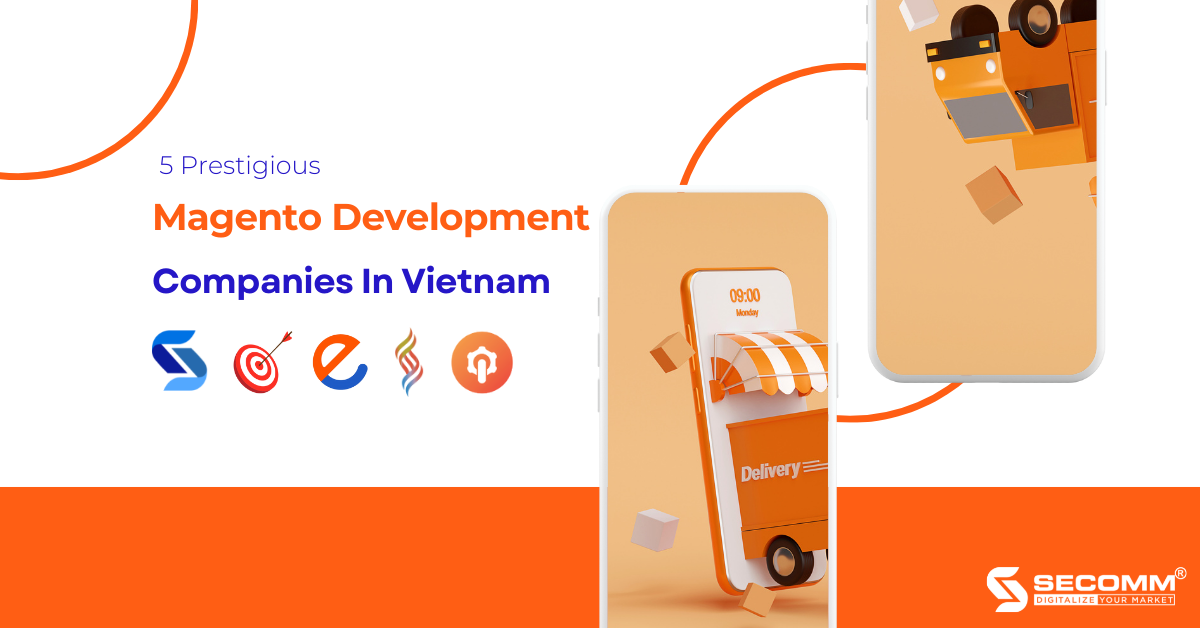
The vast and competitive eCommerce sector is witnessing the constant entry of all-sized businesses, making it challenging for many “nascent” companies to prosper in a billion-dollar market that is seen as the domain of technology giants.
Therefore, creating a professional eCommerce website is a crucial objective for new enterprises looking to take the first steps firmly, quickly dominate the market, and follow the success of the big guys.
As a result, Magento is one of the best options to consider when establishing an eCommerce website to ensure that the process is carried out successfully. It can be difficult to find a partner with strong IT skills and Magento platform development experience.
The list below details the top 5 leading Magento development companies in Vietnam that businesses can refer to make the best choice.
One of the leading consulting companies providing solutions to develop eCommerce websites with the Magento platform and Omnichannel (Omnichannel) is Kyanon Digital. through many years of operation steadily established itself as a trustworthy technology partner of many major retail groups in the Asia-Pacific region thanks to its team of qualified experts.

Magenest is a longtime technology solutions partner based in Vietnam and a leading partner of Adobe Magento, Odoo ERP, Salesforce, AWS, and Google Cloud Platform.
The company specializes in providing comprehensive hosting services and eCommerce implementation and providing package solutions in line with market trends to promote the business activities of partner businesses.
Magenest strives to support brands in achieving their goals of developing eCommerce websites with Magento. Magenest has a solid technical and consulting experience from over 30 certified consultants and developers.

BSS Commerce is an Adobe Solution Partner that provides proper Magento-related eCommerce solutions to businesses throughout the world.
The business has serviced more than 22,000 customers worldwide since its foundation in 2012, accomplished more than 500 projects, and earned the greatest level of customer satisfaction.

SECOMM is another well-known eCommerce website developer in Vietnam that is well-regarded by customers for the excellence of its work and service.
This business specializes in eCommerce consulting and offers a wide range of services, including site development, maintenance, and upgrades on platforms including Magento.
Since its establishment in 2014, SECOMM has worked with major local and foreign clients like LayByLand, Trentham Estate, An Nam Group, and others to implement eCommerce websites on the Magento platform effectively.
By simplifying all eCommerce activities, SECOMM is confident to be a reliable companion in the comprehensive digital transformation journey of businesses in Vietnam and globally.

AgileTech is a top software outsourcing company in Vietnam that has a team of experienced Magento developers who specialise in creating and maintaining high-performance E-Commerce websites.
The company is constantly up-to-date on the latest Magento features and developments, and they use this knowledge to create websites that are scalable, secure, and user-friendly during their 8-year establishment. AgileTech is committed to providing clients with the best possible Magento development experience.
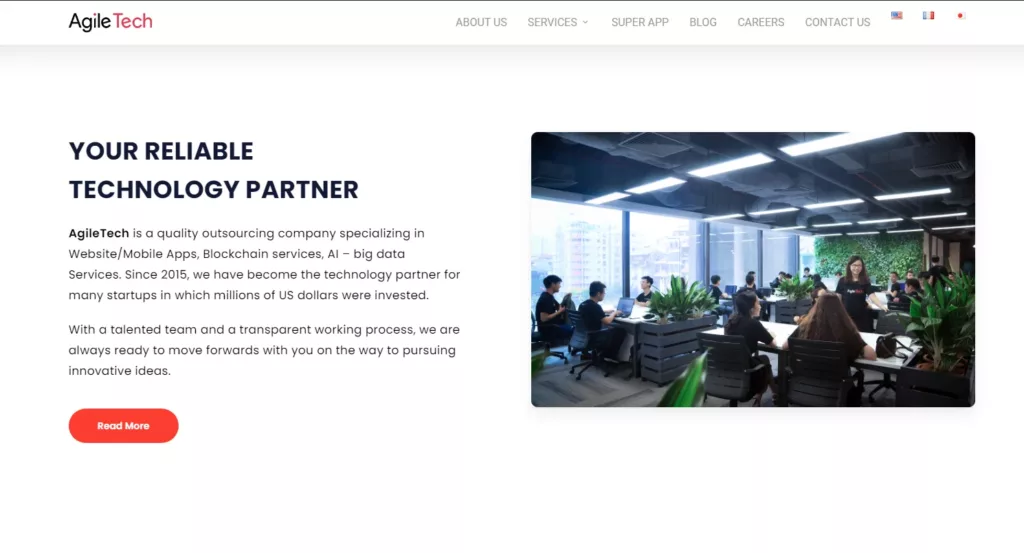
It is evident that eCommerce implementation offers businesses many advantages for entering and dominating the industry. The top 5 support firms for creating and developing eCommerce websites on the Magento platform that companies can rely on are listed above.
 2
2
 2,973
2,973
 0
0
 1
1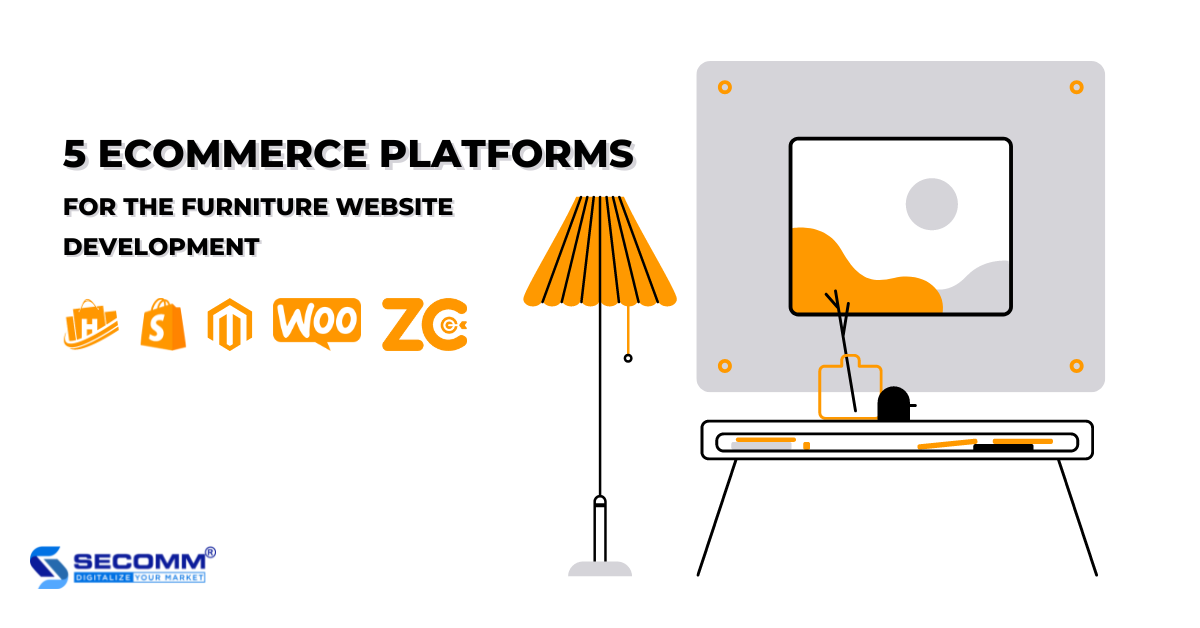
eCommerce is currently developing into a fresh and promising sales channel for furniture companies in addition to the traditional sales channel. Businesses must work hard to sustain and achieve breakthrough growth through eCommerce platforms, though.
As a result, numerous furniture companies started developing online furniture business websites and found surprising success, such Sieu Thi Noi That va Trang Tri Baya, Nha Xinh, Cozy, or Noi Phat Hoa Phat.
These websites’ success can be attributed to their early selection of an adequate and suitable eCommerce platform. Which platforms are appropriate for the furniture industry, then?
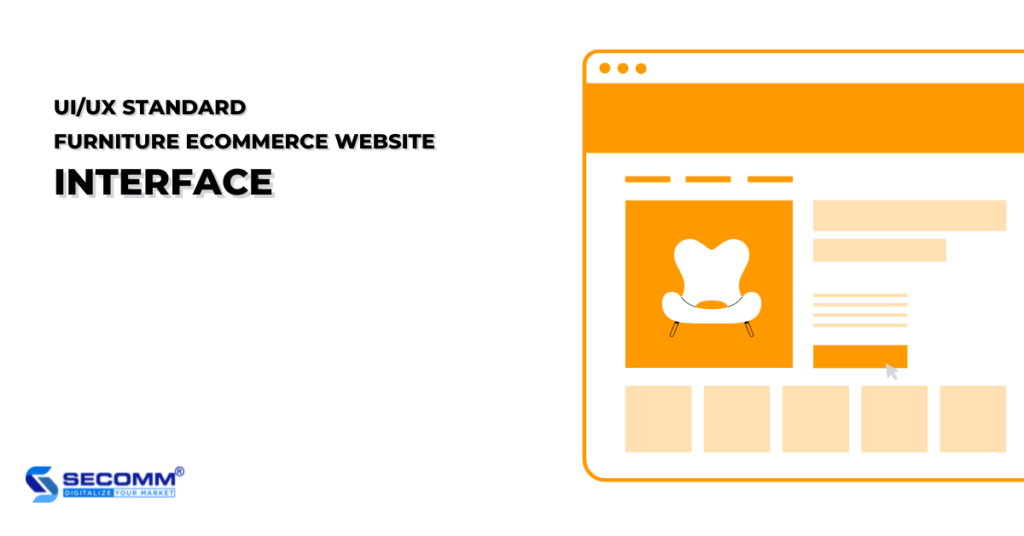
The first criterion businesses set when developing an eCommerce website is a standard UI / UX interface, friendly to users who enjoy shopping for furniture online and other home goods to increase customer interaction.
Similar to eCommerce websites in other sectors like fashion, electronics, etc., websites in the furniture sector must feature stunning and high-quality photographs and videos.
This makes it simpler for companies to communicate product information to customers, especially with banner advertisements that have an easy-to-use interface and a pleasing style that will pique shoppers’ interests.
Businesses also need to consider other concerns including call-to-action button placement, cross-device compatibility, and layout designs that display a range of product designs from the navigation bar to page-by-page details.
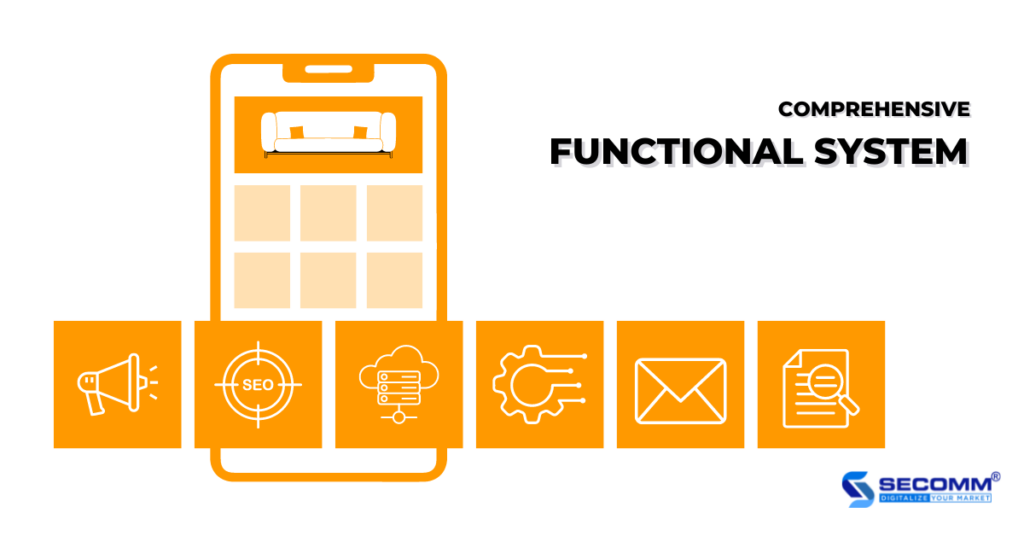
Furniture firms need a functional system from basic to advanced to fully meet consumers’ buying expectations and maximize the user experience. This system should include:
Businesses also need to develop some additional specialized features to address the furniture industry’s “own challenge,” such as:
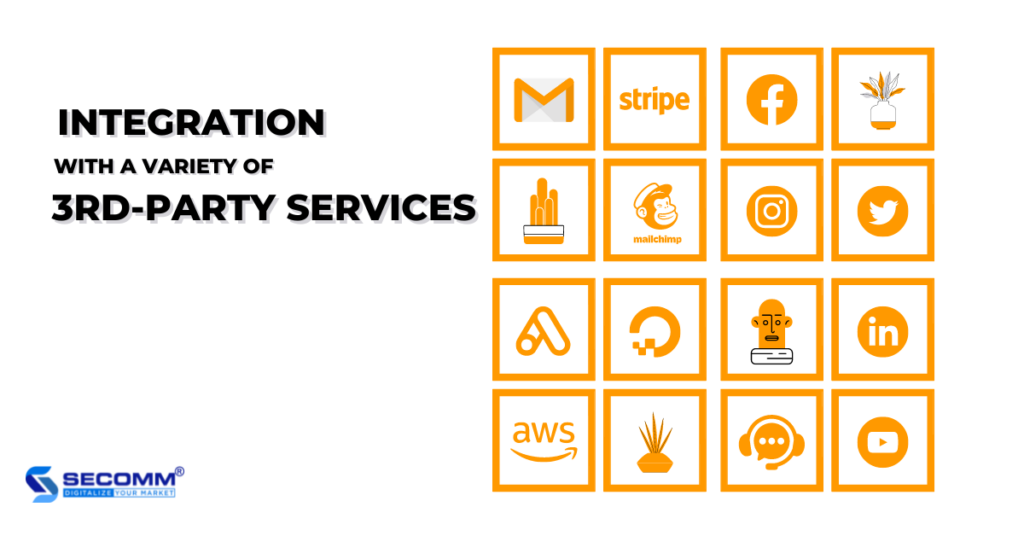
Furniture businesses frequently integrate a range of payment options, shipping services, management software, and business analysis tools to optimize eCommerce business systems in order to provide customers with a comprehensive shopping experience.
Some popular payment methods businesses can integrate on the website to diversify payment methods to help customers have many choices such as card payment; eWallet; payment gateways.
Businesses might take into consideration software like ERP (SAP, Salesforce, Oracle), among others, when integrating back-office administration and operation software.
Finally, incorporating BI tools like Tableau, Looker, etc. will aid in the long-term analysis of business plans.
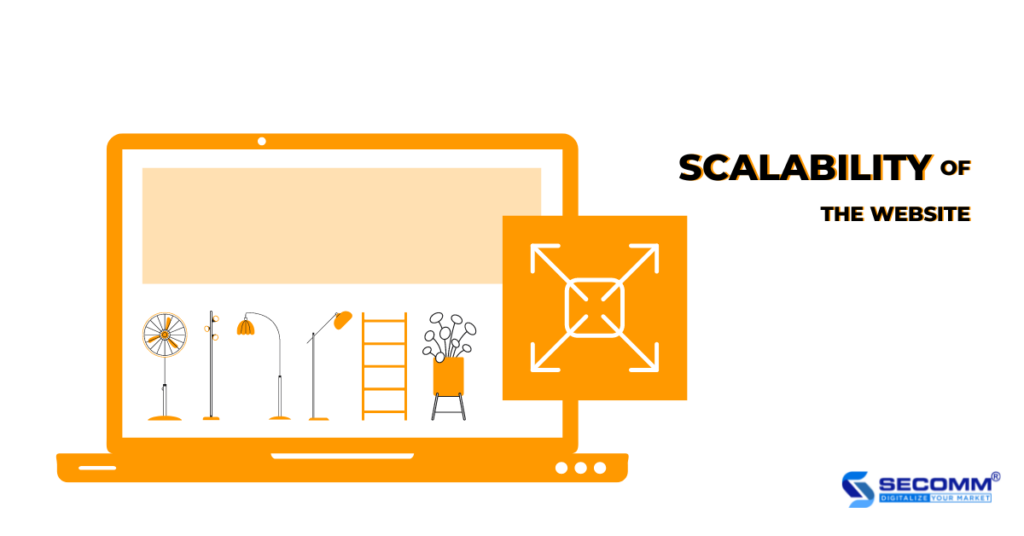
Businesses that are just starting to use eCommerce won’t concentrate on the website’s scalability in the future because platforms that provide this feature are sometimes hard to find. But tactically, spending money on a platform that facilitates this function will provide organizations an advantage over rivals in the market.
These aid furniture companies in making necessary adjustments, creating new features, and expanding their online systems to support several stores, languages, and currencies in the future.
Haravan was founded in 2014 and is a very popular and popular eCommerce deployment platform in the Vietnam market with a variety of solutions for businesses and individual sellers.
Pros:
Cons:
=> Rating: 2/4
Haravan is suitable for start-up furniture businesses or SMEs (small and medium-sized enterprises) with operations mainly in Vietnam.
Shopify is a popular SaaS platform in the world that provides a variety of solutions for businesses of all sizes to successfully build eCommerce websites.
Pros:
Cons:
=> Rating: 2/4
Shopify is considered suitable for start-ups or SMEs with global operations.
ZielCommerce is an eCommerce platform with ready-made solutions specialized for the furniture industry.
Pros:
Cons:
=> Rating: 3/4
ZielCommerce will be the optimal choice for B2B, and B2C furniture businesses to deploy eCommerce websites or build mobile apps. However, this platform is not really popular in the Vietnamese market but is especially favored by foreign furniture retailers such as Frampo, Zeyka, etc.
WooCommerce is a free WordPress plugin that allows businesses to transform a regular WordPress website into a professional eCommerce website with full features and easy customization with just a few simple steps.
Pros:
Cons:
=> Rating: 3/4
WooCommerce will be suitable for furniture businesses who are familiar with the WordPress platform and want to develop an eCommerce system.
Magento is a popular open-source commerce platform in the field of eCommerce, with nearly 200,000 websites in use. Currently, Magento has 2 versions: Magento Open Source (free), and Magento Commerce (paid).
Pros:
Cons:
=> Rating: 4/4
Magento is appropriate for a range of furniture business types, including B2B, B2C, and B2B2C, as well as for various business sizes, including start-ups, SMEs, and major companies. However, large organizations use Magento because it is frequently relatively expensive to deploy.
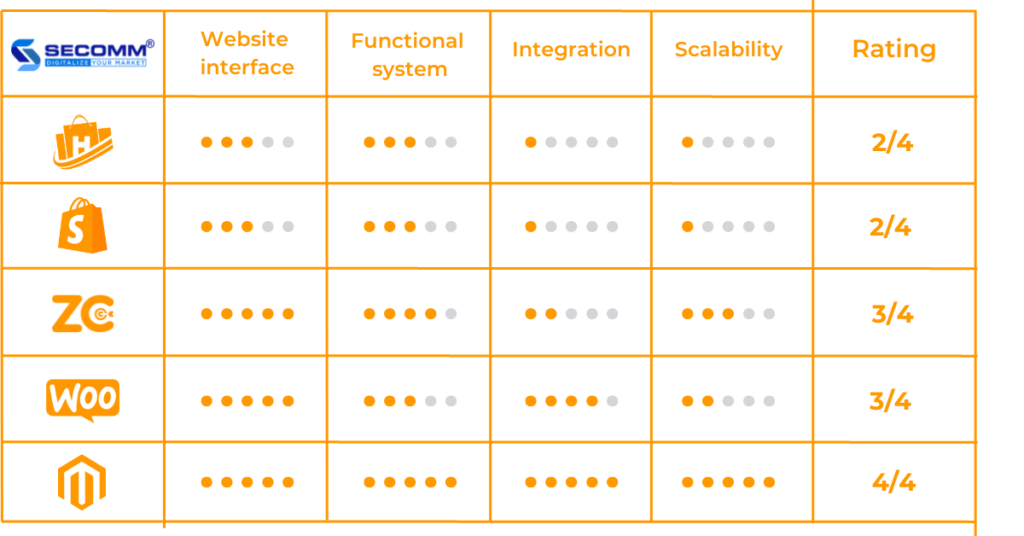
Choosing the right platform is an extremely important first step when building an interior eCommerce website. Choosing the right eCommerce platform will help businesses save budget and time to build a website while increasing competitive advantage and sustainable growth. On the contrary, when choosing the wrong platform, it will cost businesses a lot of time and budget to deploy and switch platforms many times. Therefore, businesses need to consider the goals and problems in the current model to be able to choose the most suitable platform.
With many years of experience in successfully implementing eCommerce for many customers in many countries, SECOMM specializes in providing consulting services with comprehensive and professional eCommerce implementation solutions.
Contact SECOMM today for free support and advice.
 2
2
 4,966
4,966
 0
0
 1
1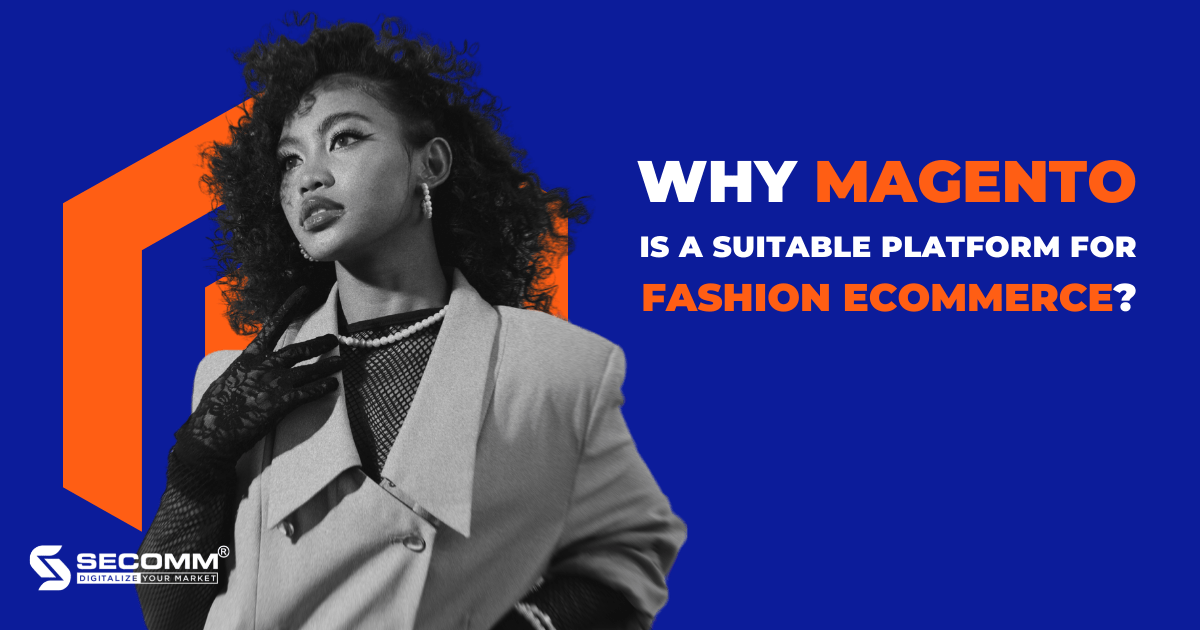
Fashion eCommerce has shown excellent development potential in recent years, with a worldwide market worth USD 759.5 billion in 2021 and predicted to reach USD 1 trillion by 2025. Clothing (+12.7%), Footwear (+11.6%), and Bags and accessories (+8.5%) are expected to increase the fastest in 2023.
Furthermore, fashion is one of the “four pillars” of Vietnam’s e-commerce economy, accounting for 43% of all online purchases, trailing only the eGrocery industry. According to the e-Conomy SEA Report 2021, 47% of Vietnamese respondents think that fashion eCommerce has become a consumer purchasing habit.
Despite the numerous prospects, this industry has multiple problems, including numerous rivals, continually changing consumer preferences, pushing firms to diversify models, Omnichannel sales to create more customer touchpoints, and so on.
As a result, to properly deploy fashion eCommerce, company managers must examine various elements, including the fundamental factor of developing a website. Among eCommerce platforms such as Shopify, BigCommerce, and WooCommerce, Magento is renowned as a platform used by many famous brands to establish eCommerce, including Canifa, Hoang Phuc International, OnOff, and others. So, why have these companies selected Magento?
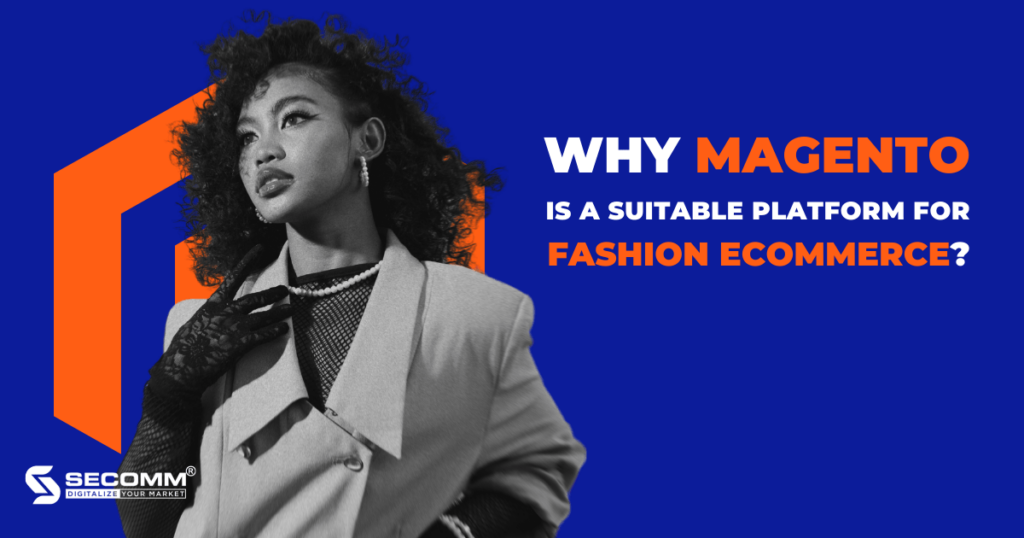
The demanding consumer base with excellent aesthetic sensibility is a common element of the fashion sector. This necessitates that fashion firms concentrate on the design of the eCommerce website interface, particularly the homepage, which must be professional and eye-catching.
The disadvantage of online fashion purchasing is that you cannot “See it with your own eyes, touch it with your own hands.” Therefore, the more detailed and colourful the image/video, the more authentic and trustworthy it will appear to buyers.
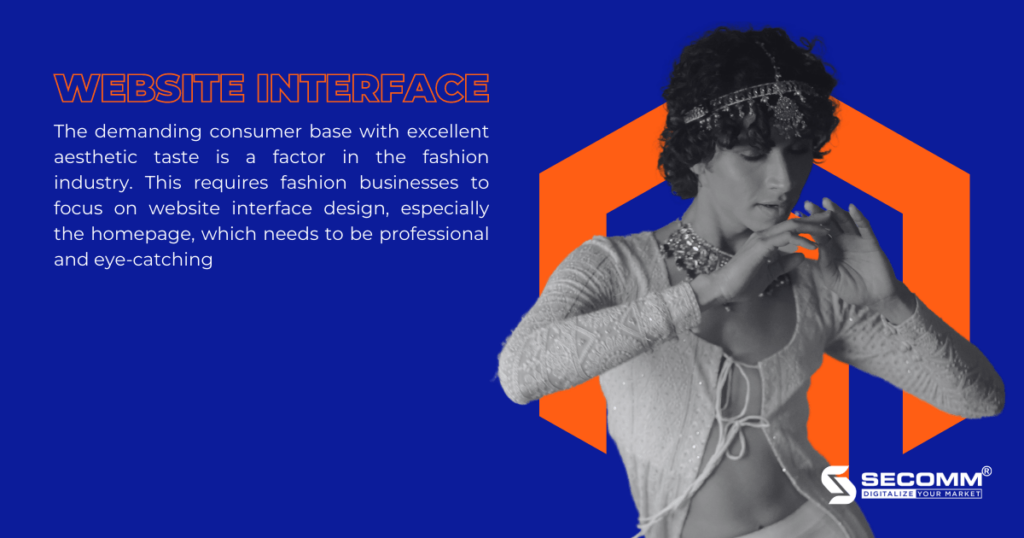
In terms of the UI (User Interface), visualisation affects the capacity of customers to engage with the website, helping to answer the question: “Has the user being able to navigate clearly from one page to another in a convenient way? “
Another website interface design is user experience (UX), from consistency in call to action button (CTA) or illustration locations, everything should be more convenient to create the most consistent experience for all website users.
Many functionalities are required for an online fashion business website to satisfy industry requirements.
The fashion sector is distinguished by multichannel sales and numerous client touchpoints. For instance, on e-commerce platforms (Shopee, Lazada, Tiki, Sendo), social networking channels (Facebook, Tiktok, Zalo, Instagram), and e-commerce websites and applications. When implementing eCommerce for fashion companies, administrators must employ an Omnichannel approach.
Usually, the fashion industry will have a lot of product categories and collections, from clothes, and shoes, to bags and accessories, so consumers’ need to search for products on the website and e-commerce app is very high. From there, businesses should build multi-layer menus and advanced product search functions by keywords or filters to serve the needs of searching and navigating customers.
Furthermore, because fashion is a highly competitive market, the more influential the communication strategies, the more orders the brand will obtain. Loyalty Programs, Livestream, Shoppertainment, Affiliate Marketing, and other fashion-related communication strategies on websites and mobile apps.
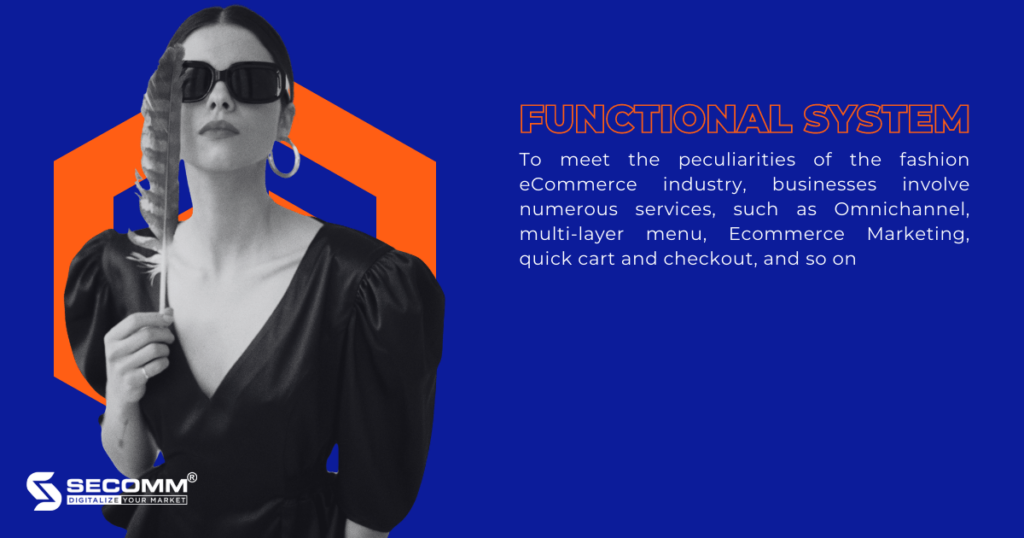
Clothing, bags, shoes, and fashion accessories are frequently low-involvement goods, thus creating a rapid shopping cart function would assist consumers to speed up the purchase process, increasing online sales for businesses.
Businesses should construct a feature to help categorise consumers to take care of and tailor the experience for each type of client in the fashion sector, which frequently has several customer groups, such as new, old, and VIP. From there, organisations will gradually use the understanding of each sort of consumer to develop better business solutions in the future.
After all, fashion eCommerce systems must frequently manage high traffic levels during peak seasons.
Businesses require a highly integrated website construction platform to properly execute fashion eCommerce, including Omni-channel, management system, payment, shipping, analytics, and reporting.
Because the fashion industry is distinct, it needs considerable coverage across all sales channels to reach many potential customers. Therefore, while implementing eCommerce, businesses have to use an Omnichannel strategy. However, to synchronise all data from front-end to back-end when deploying Omnichannel, companies require a highly linked system across all sales channels.
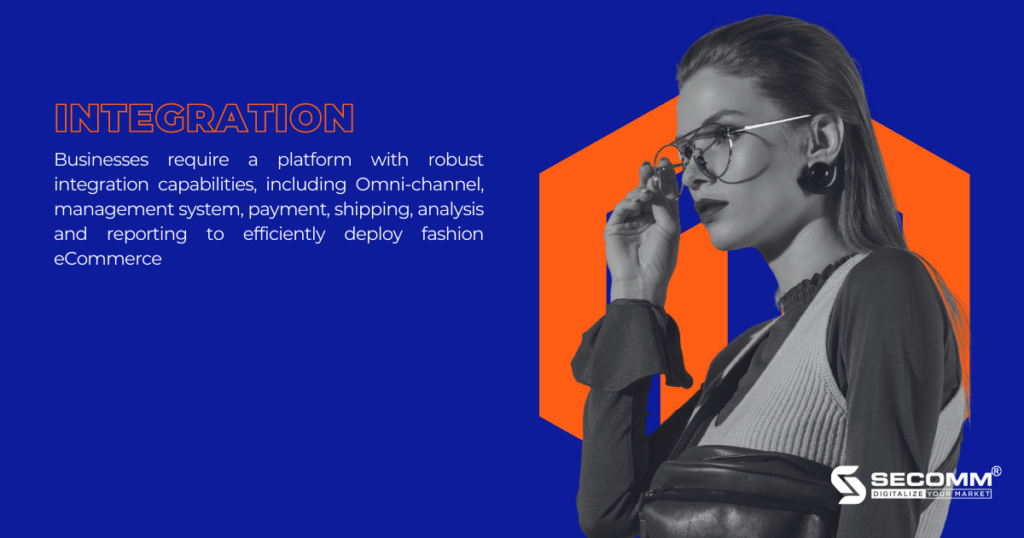
Simultaneously, fashion firms frequently utilise several third-party management systems such as POS, CRM, ERP, and BI, so businesses must find an eCommerce platform that can combine and manage all data information on” a single screen”
Furthermore, companies must vary payment and delivery methods so that clients have more options when buying fashion goods.
Finally, organisations must integrate analytics and reporting tools to provide real-time measurements with the most user-friendly reporting table. From there, firms could provide more practical guidance in the future.
Fashion businesses will have many different sizes, from startups, SMEs (small and medium enterprises), and new entrants to large corporations. Moreover, each business will have a different operating model, such as B2C, B2B2C, and so on.
All sizes and operating models will have unique requirements for each stage of brand development, so businesses need a platform to accompany them throughout the journey, preventing the circumstance of switching platforms consumes time and money when firms install eCommerce.

In summary, companies require a comprehensive platform to efficiently implement fashion eCommerce for the long run, including website interface, functional system, integration, and scalability.
When designing a fashionable eCommerce website interface on the Magento platform, businesses have many choices, including using existing themes, customising themes, and designing their own interface.
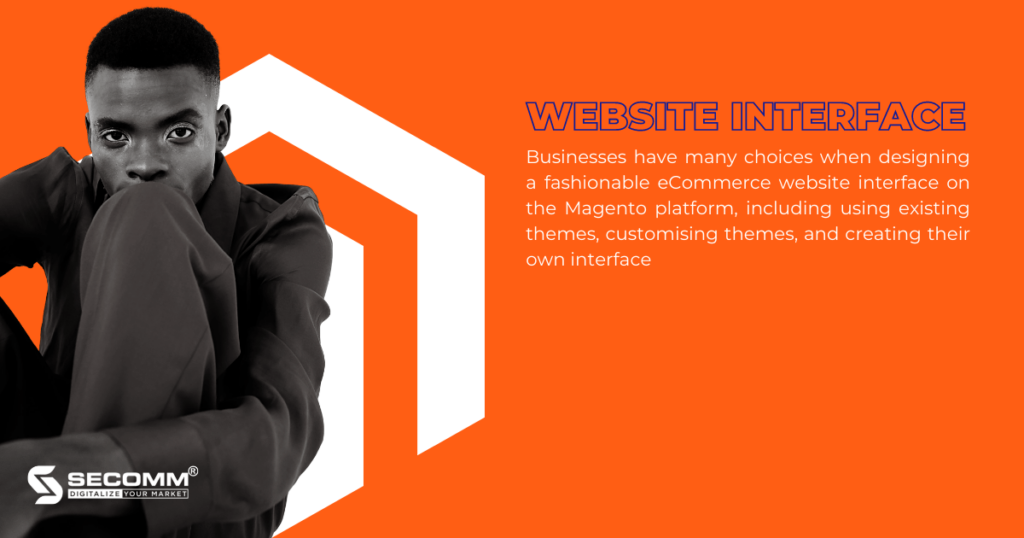
For using existing themes, companies may find these in the marketplace, developer community, or partner for Magento-specific themes in the fashion industry. This helps businesses reduce the expense of interface design, but it limits firms’ brand positioning because the interface is easily imitated by other websites.
For customising themes, businesses can save money and add brand identification aspects like colours, fonts, layout and so on. However, to efficiently set up and customise the website interface, businesses require a team with significant knowledge and experience.
For designing their own interface, businesses will have a “tailored” website for their fashion brand. However, this will necessitate a more significant investment in development expenditures and a more competent workforce.
When using Magento to develop an eCommerce website, most fashion businesses often choose a customised theme or design their own interface to support a centralised eCommerce business.
The Magento platform has all the capabilities needed to create a comprehensive eCommerce website, from essential to complex. At the same time, this platform permits the development of custom functions to tackle unique difficulties in the fashion business.
Basic features that assist businesses in running an efficient and seamless fashion eCommerce website, such as:
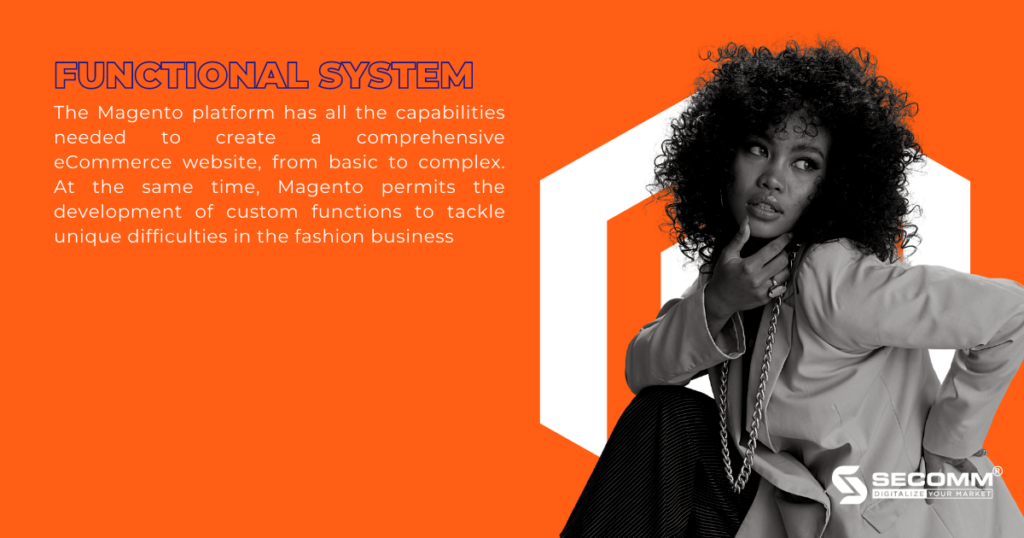
Advanced functionality that enhances the online shopping experience for consumers, such as:
Specific functions are those that assist businesses in dealing with fashion industry issues, such as:
In general, Magento can create any sophisticated functional system, with infrastructural development before and after depending on the demands of each organisation.
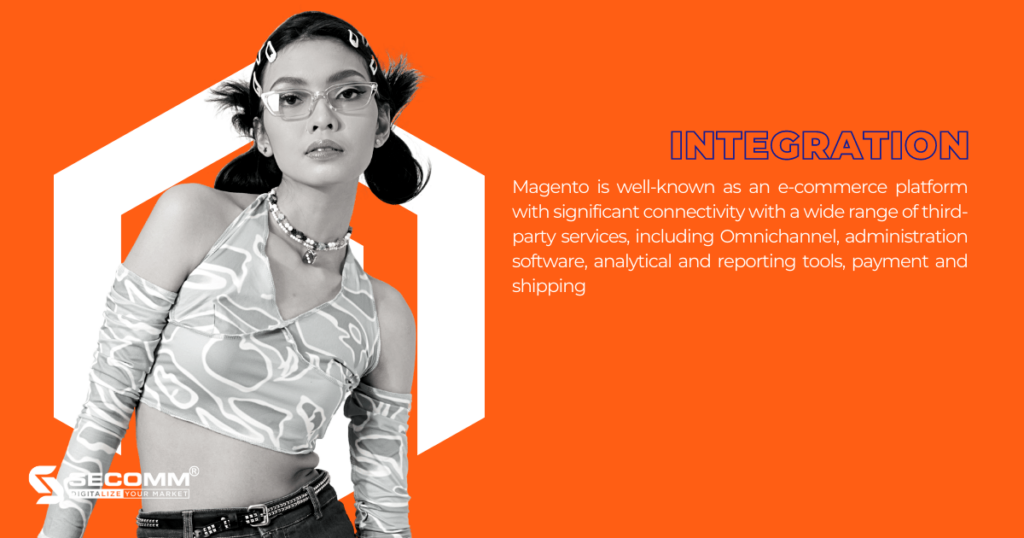
Magento is well-known as an e-commerce platform with significant connectivity with a wide range of third-party services, including Omnichannel, administration software, analytical and reporting tools, payment and shipping.
Magento allows organisations to extend from one website to many distinct websites on the same system to satisfy the requirements of company-scale development. This implies that organisations can access and manage data from a single central Magento system.
With Magento’s language-switching functionality, businesses can create an attractive eCommerce website with customer-friendly content and languages. Furthermore, the Magento system enables businesses to effortlessly exchange currencies, allowing them to grow into new markets in a variety of nations.
From then, Magento can help businesses scale and function effectively without switching to another eCommerce platform from the beginning of business through the period of expansion.
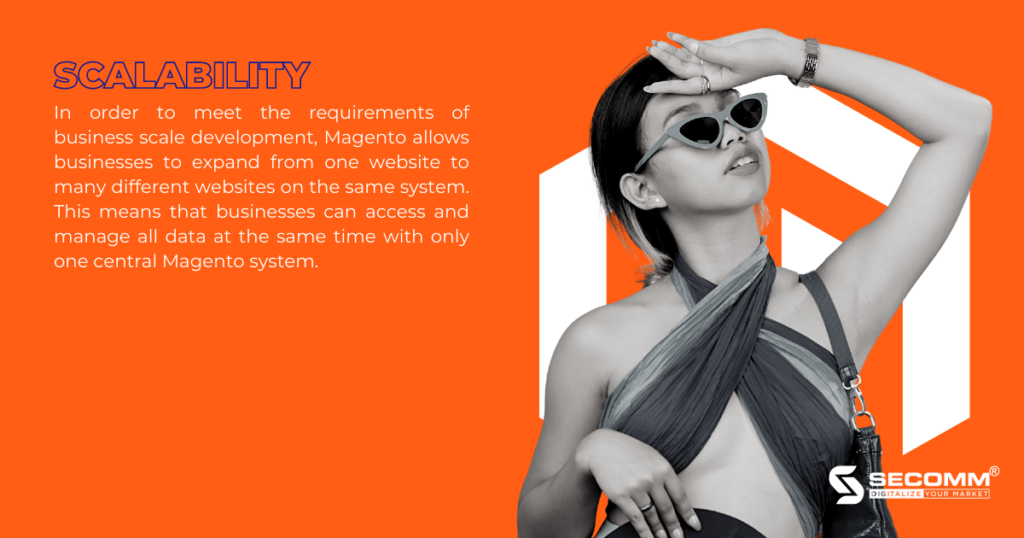
In a nutshell, Magento is an e-commerce platform that caters for the demands of all types and sizes of fashion businesses, from website interface design and functional system development to integration and scalability. However, there are numerous challenges that firms must overcome when implementing fashion eCommerce with Magento, such as high installation costs, long construction times, and the requirement for highly skilled employees.
Recognising the aforementioned business difficulties, SECOMM provides free consultation services on technology and resource solutions for each company.
Contact SECOMM now for more details!
 2
2
 6,163
6,163
 2
2
 1
1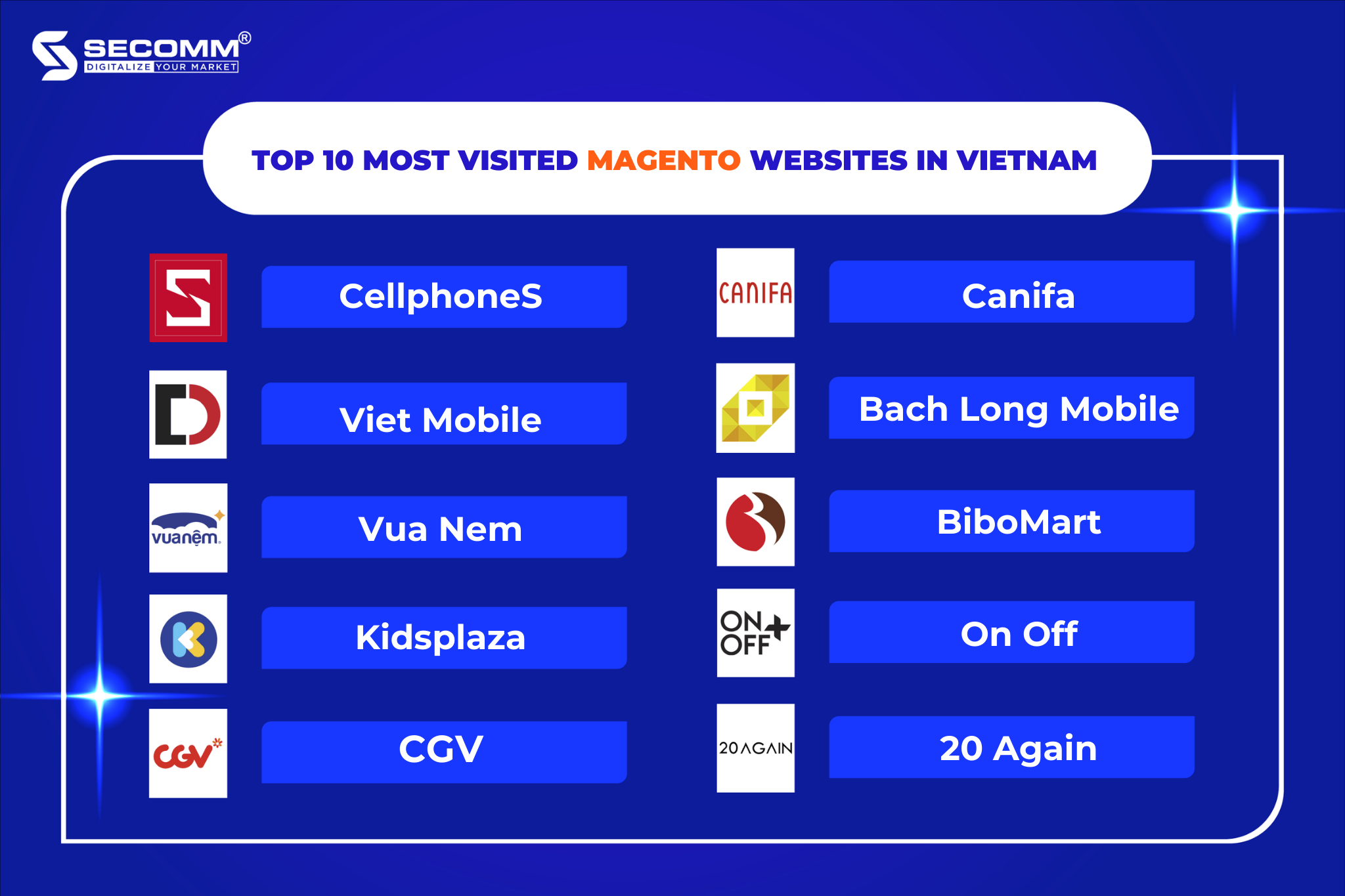
Magento is the leading open source eCommerce platform, powering over 186,000 websites worldwide. However, this platform has not been widely used in Vietnam, particularly among the community of new businesses entering the eCommerce market.
Magento is an open-source eCommerce platform written in the PHP programming language. Magento currently has two versions: Magento Open Source (free) and Magento Commerce (paid).
Inheriting outstanding advantages of open source eCommerce platform:
In Vietnam, CellphoneS is a well-known retail system for technological products. The company is currently operating in Ho Chi Minh City, Hanoi, Binh Duong, Hai Duong, Hai Phong, Bac Ninh, Vinh Phuc, Thai Nguyen, and Vung Tau.
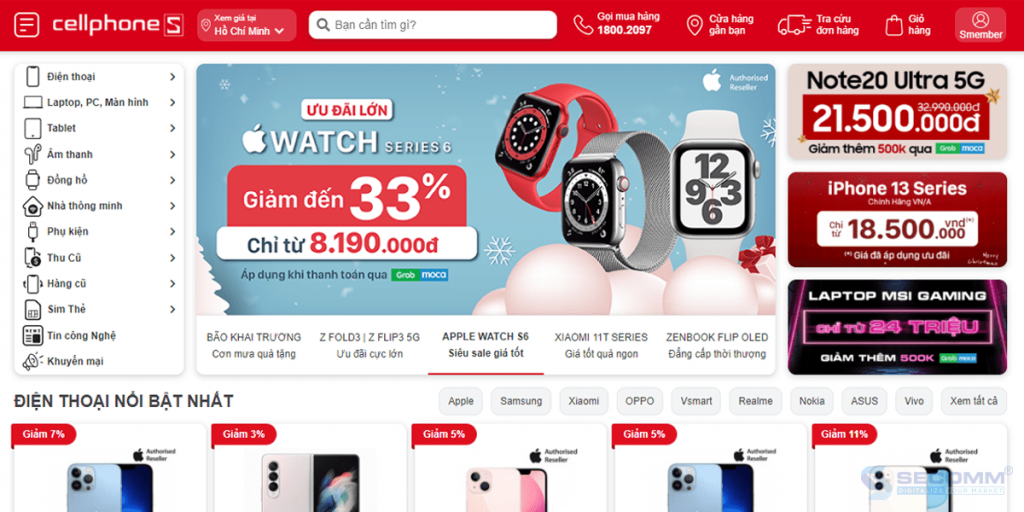
Viet Mobile is a reputable electronics brand and a strategic partner of global technology corporations such as Apple, Samsung, Apple, OPPO, Sony, ASUS, and others.

Vua Nem is a leading retail chain of mattresses, blankets, sheets, pillows and accessories with more than 100 stores spanning from North to South.

Kidsplaza is a big star in the mother and baby industry, with over 133 locations nationwide.\

CGV, along with Galaxy, Lotte Cinema, BHD Star Cineplex, and CineStar, is one of the top five largest cinema clusters in the world and a major distributor and cinema cluster in Vietnam.

CANIFA is a fashion brand that specializes in designing clothes, accessories, and retailing casual wear for families. It is currently owned by the Hoang Duong Textile Group.

Bach Long is one of the popular retailers of smartphones, tablets, and technology accessories in Vietnam.
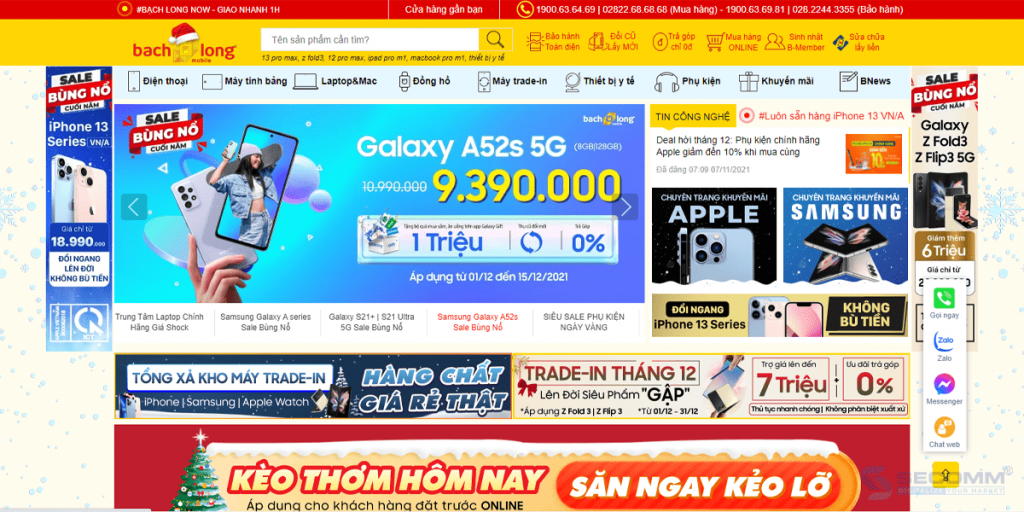
Bibo Mart is a Vietnamese supermarket chain that sells and services to mothers and babies. Bibomart used eCommerce in 2019 to reach customers and expand its online business.

On Off is a lingerie brand founded in 2005 to bring everyone comfort every day.

20 Again is a women’s fashion brand with 3 main product lines: Office Wear, Dress Design, and Street Wear.
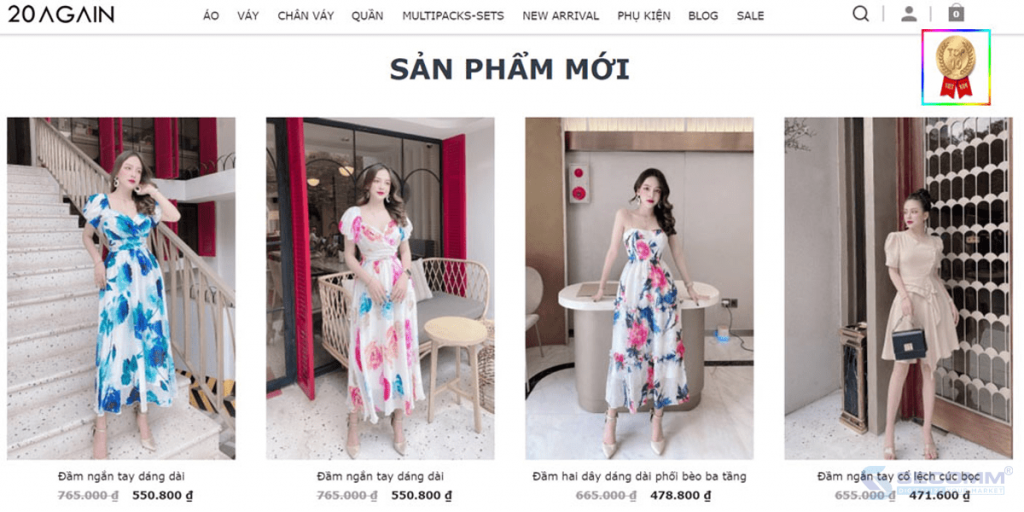
Contact SECOMM now for a free consultation on eCommerce development roadmap on Magento platform.
 3
3
 5,287
5,287
 0
0
 5
5
Platforms play a significant role in developing and operating an optimal eCommerce system. As a result, selecting an eCommerce platform should be done thoroughly and carefully to maximize the platform’s benefits and promote long-term business growth. Each business’s eCommerce model will have appropriate platform options depending on the development goals. However, most SMEs today face significant challenges in selecting a suitable eCommerce platform due to a variety of budget, time, and business characteristics.
The Magento eCommerce platform is the most fantastic platform for eCommerce systems among popular names such as Shopify, BigCommerce, WooCommerce, and so on. Magento has many distinct advantages, including high flexibility, a diverse ecosystem, and optimal security. However, are Magento’s outstanding features the best option for SMEs? So, what are the standout characteristics of the Magento eCommerce platform? Will they be appropriate for SMEs in the Vietnamese market?
The Magento eCommerce platform is designed to grow into a comprehensive eCommerce system.
+ Integrate Google Analytics to track and report on traffic, audience, purchasing process, and purchasing behavior.
+ Integrate Facebook Pixels makes tracking ads performance and capturing website actions simple.
+ Integrate Google Tag Manager to quickly update website metrics and related tags to increase personalization and accomplish the proper goals for the subsequent Marketing campaigns.

The Magento extension system has also been significantly developed to meet the eCommerce market’s rapid development and the specific requirements of each business.
Thousands of advanced functions on themes, add-ons, products, Marketing, payment optimization solutions, shipping, and so on have been built with flexibility and high usability to deliver exceptional results when integrated into the system that meets all operational needs and ensures the long-term growth of businesses’ eCommerce.
Businesses can fully integrate third-party services, analytics tools, management software, and Omni-channel with the Magento eCommerce platform to support efficient and seamless eCommerce operations.
In addition to a fully functional feature system, the Magento eCommerce platform is supported by a diverse system of extensions and technologies from a global developer community, allowing all eCommerce requirements of SME businesses to be met quickly anytime, and anywhere. The Magento eCommerce platform has a large developer community worldwide, including many experienced professionals and Magento developers.
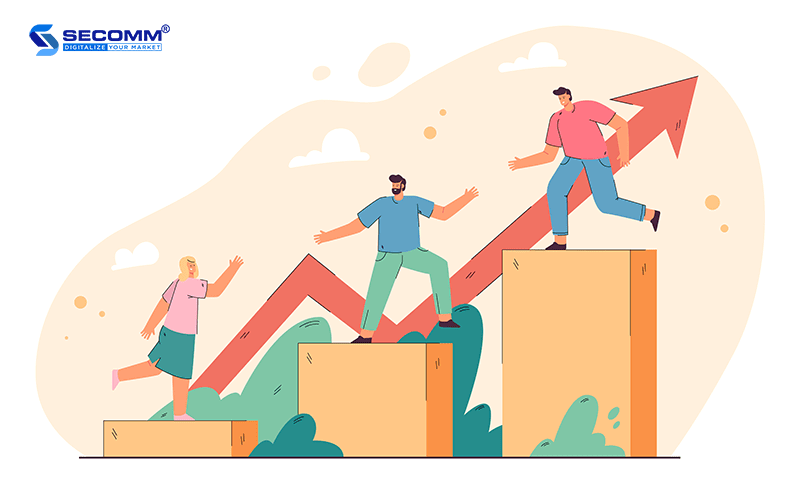
Businesses will receive maximum support in solving problems arising from technical errors and consulting on building eCommerce solutions that fit the enterprise’s business model with a strong Magento eCommerce platform development community.
An extensive technical support community is another example of the reliability and capacity to quickly resolve system errors and updates that Magento constantly brings to our eCommerce system.
The Magento eCommerce platform’s flexibility is an exceptional advantage that allows the Magento eCommerce platform to operate any complex system. Given this benefit, Magento is an excellent choice for Vietnamese SMEs today. Moreover, businesses can easily change system functions, develop new features, or open new stores to meet their needs and respond to rapid market change.
The Magento eCommerce platform possesses the advantages of open-source software with extensive customizability to help the system run smoothly. Enterprises can easily own and control the entire system source code and customize it to change parts to suit the eCommerce system’s general operating model.
Owing to this benefit, Magento is highly customizable for any size business and can meet the eCommerce needs of both small and large corporations.
Besides that, the customizability of open-source code enables developers to create more innovative and comprehensive solutions tailored to each business, field, and business model, creating highly specialized eCommerce functions that result in effective system performance.
Magento allows businesses to scale from one website/store to many different websites/stores on the same system to meet the needs of business scale development. Businesses can access and manage all data from multiple websites/stores using a single Magento system.
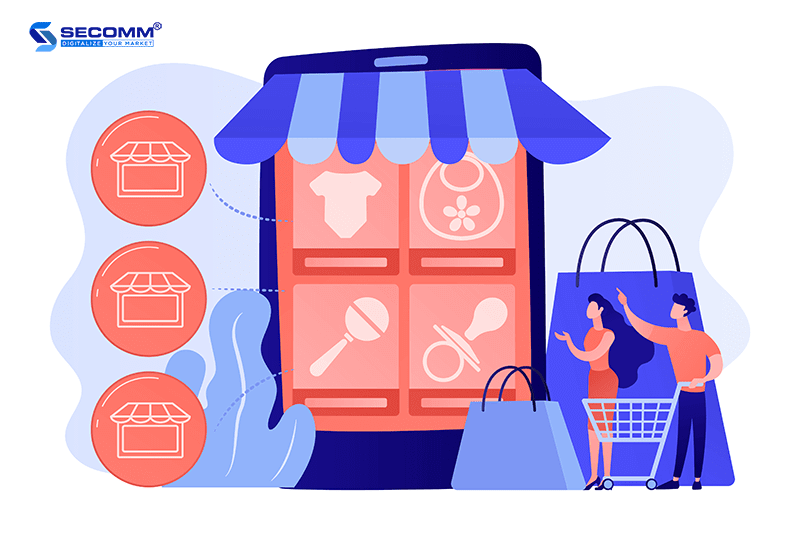
With Magento’s language conversion support, businesses can create an eCommerce system with customer-friendly content and language. Besides that, the Magento system enables businesses to quickly convert currencies, expand their markets in many countries, and assist customers in transacting conveniently and having the best shopping experience.
High security is another significant benefit that makes the Magento eCommerce platform the preferred choice for SMEs. Magento is a complete eCommerce system with security functions that ensure seamless eCommerce operation while minimizing potential data system and ecommerce transaction processing risks. As a result, system security is improved, website credibility is increased, and user interests are protected to the greatest extent possible.

Magento includes a periodic security scan tool to identify security issues or malware affecting the system and update patches and notifications, then propose security solutions to handle arising errors, thereby effectively improving and optimizing the website’s security.
The requirement to use advanced passwords should also be fully implemented to increase the level of security for administrative accounts. The administrator password must be at least seven characters long and include letters, numbers, and special symbols. Relating to further adjustments, the password complexity may be increased with lower case/case sensitivity, or re-login may be required after a certain length of the login session.
CAPTCHA can protect the system for both administrators and website visitors. In addition, using CAPTCHA aids the system in preventing bot spam and malicious code from entering the system illegally.
This function provides additional security for system user accounts. Accordingly, customers will have to authenticate with an additional OTP security code sent to the phone number provided during account registration after logging in with a password. This two-layer security operation effectively limits the threats of unauthorized access and account attacks while enhancing protection and maximum safety for system users.
With significant advantages such as a fully functional feature system, flexibility, a diverse ecosystem, and optimal security, the Magento eCommerce platform is the best choice for SMEs looking to build a stable and sustainable eCommerce system. However, due to deployment costs, implementation time, and complex industry-specific issues, most SMEs are still hesitant to use Magento to build an eCommerce system.
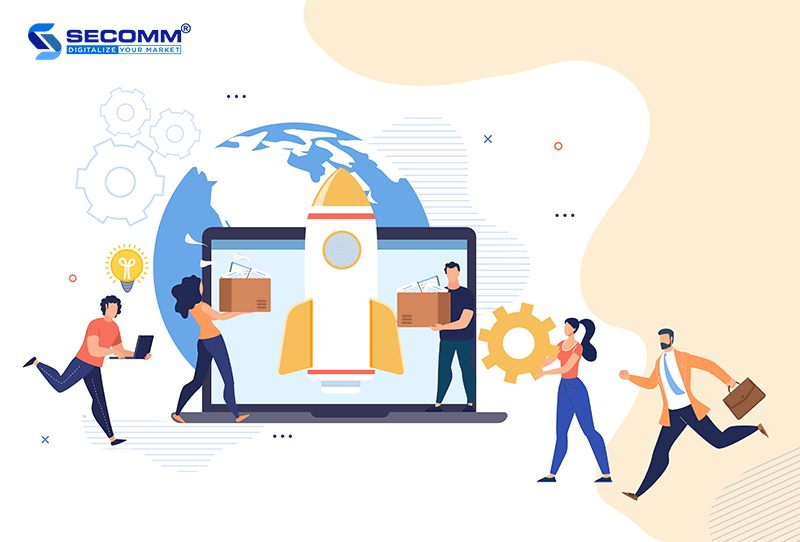
Although Magento is highly regarded for its features and performance, the cost barrier prevents SMEs from selecting the Magento eCommerce platform to build their system. Furthermore, the expertise of the system developers is a significant factor that significantly increases the cost of Magento implementation. Therefore, a complete and efficient Magento eCommerce website is implemented by a professional team that is thoroughly knowledgeable about Magento to develop the proper comprehensive system from the beginning and provide appropriate solutions for the enterprise’s various needs in the long run.
A fully functional system built on the Magento eCommerce platform is estimated to cost between $10,000 and $100,000.
A complete project on the Magento eCommerce platform typically takes 2-3 months to deploy, with some projects taking up to a year. Additionally, enterprises should constantly develop components of the eCommerce system. Furthermore, the functional system’s complexity necessitates time investment to build appropriate development solutions.
When selecting an eCommerce deployment platform, SMEs should consider the time issue carefully. With the requirements of the eCommerce and digital transformation markets, the extended system implementation time slows down the digital transformation process, making it difficult for businesses to keep up with competitors or constantly update trends in the market.
When converting to eCommerce, the specific characteristics of each industry and field remain a complex problem for every SME. Because most Vietnamese SMEs lack the technical knowledge and expertise required to build particular functions that can satisfy one or more specialized processes and the complexity of the eCommerce system, industry specificity has become a significant obstacle. These specific functions necessitate a corresponding technological solution to ensure that the eCommerce system can operate effectively and sustainably after the transformation.
Simultaneously, to build a specific feature with high complexity for a Magento store, businesses may need to spend more money and time than usual to develop a suitable solution to the particular requirements of an eCommerce business.
With extensive experience developing many complex e-commerce systems on Magento, SECOMM understands the challenges that businesses face when selecting a platform and implementing E-commerce.
Contact SECOMM for a free consultation on comprehensive e-commerce system development solutions!
 2
2
 5,535
5,535
 0
0
 1
1
Since its inception, Magento has maintained its distinct position in the eCommerce development community. One of the primary reasons for this is that Magento has a diverse, highly applicable feature system compatible with all business models (B2B, B2C, B2B2C, D2C).
SECOMM will introduce some “cool” Magento features for businesses to consider
The Multi-Brand Solution is a multi-language, multi-currency, and multi-store solution that helps businesses unify all content and products on a single “screen.” Businesses with various brands, stores, or business models can set up multiple pricing structures, display a wide range of product types, and customize payment methods for any audience ( B2B, B2C, B2B2C, D2C).
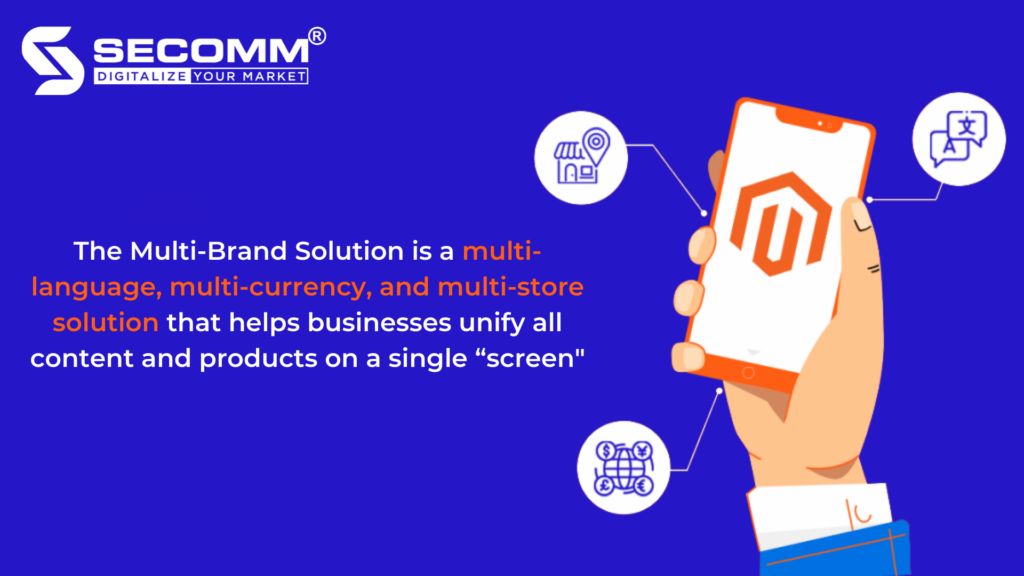
This function assists businesses in increasing sales by utilizing all content to create eye-catching websites to maximize customer information. As a result, targeting different customers with product recommendations and promotions is possible. Simultaneously, the adaptability enables businesses to personalize the purchasing experience through customized categories and pricing.
MSI is a prominent feature of Magento 2 (starting with version 2.3.0) that allows businesses to easily manage products from multiple stores, significantly improving inventory management regardless of customer location, warehouse, or sales channel.

This feature enables businesses, particularly dropshipping businesses, to ship one order containing multiple products from multiple warehouses while ensuring on-time delivery to customers.
Magento’s headless Commerce is an eCommerce architecture that separates the frontend (which represents the user interface) from the backend (which means the eCommerce functionality). The front and backend are linked together by an API, allowing businesses to easily customize and update without interfering with the user interface or CMS pages.
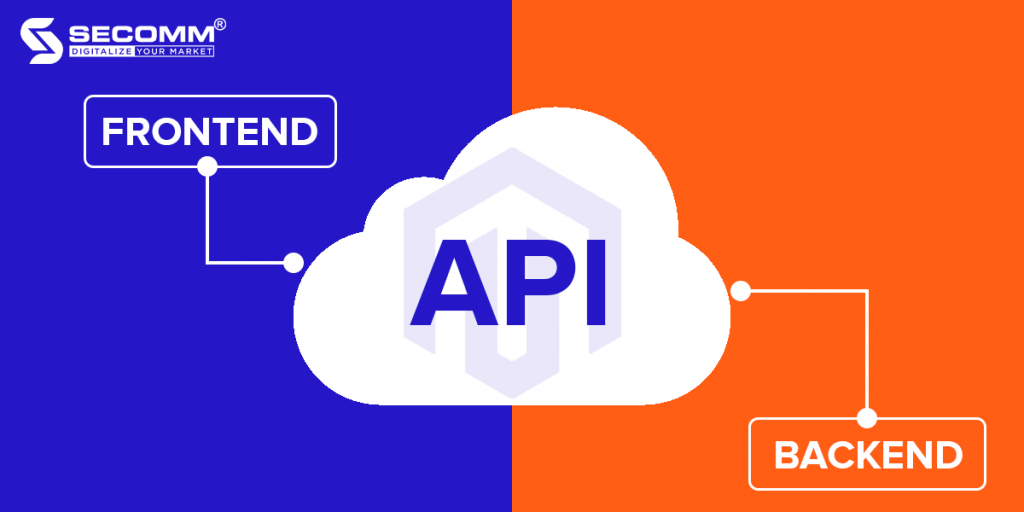
Thanks to the applicability of Headless Commerce, Magento websites benefit from faster page load times and personalized user experiences at a lower long-term cost.
Magento allows you to track and measure eCommerce system performance using built-in tools like Google Analytics, which tracks and reports traffic, audience, purchasing process, and purchasing behavior.
Use Google Tag Manager to quickly update website metrics and related tags to increase personalization and reach the right goals for the following marketing campaigns.
Use Facebook Pixels to measure ad performance and capture actions taken on the website.
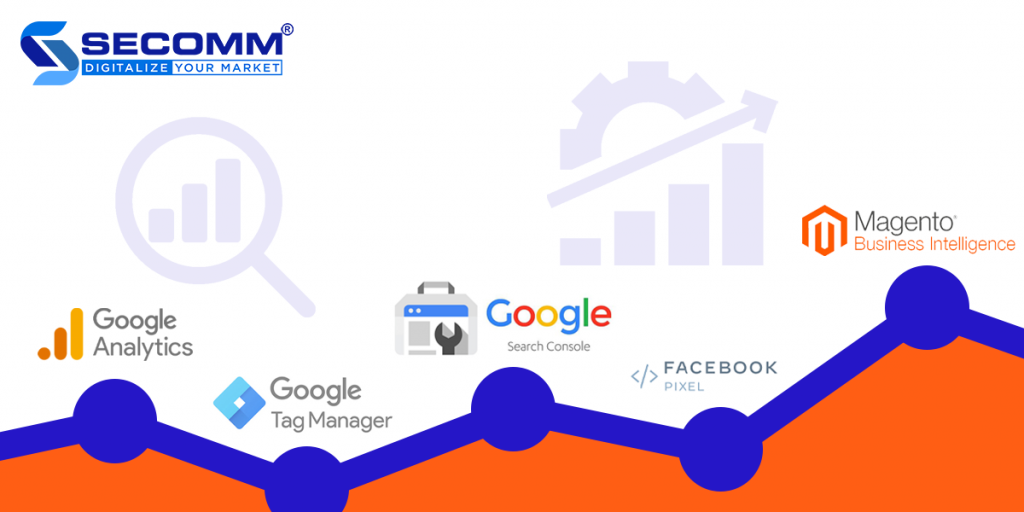
Furthermore, Magento supports Business Intelligence (BI) analysis. Magento BI is a cloud-based platform that allows you to consolidate and manage data sources, create data models, and create charts and reports from a single screen. Sending out periodic reports also helps to control information sharing.
Specially designed for B2B customers, supporting various functions like:
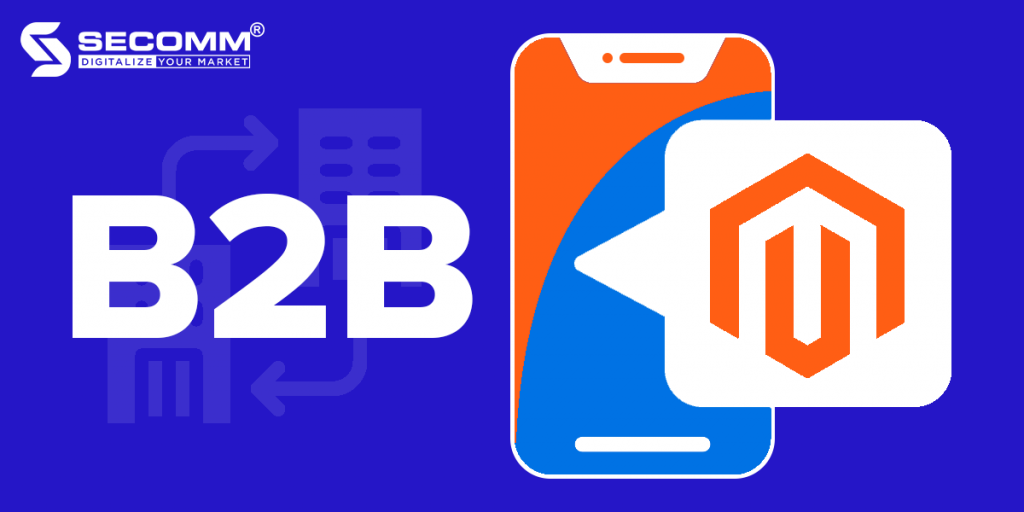
All of these features assist businesses in managing user accounts via the customer portal, allowing them to quickly set up multiple levels of buyers with specific roles and benefits.
In addition, companies can track quotes and orders, define purchasing rules, and manage credit online simultaneously. Since then, business and management in the B2B model have become more efficient and faster.
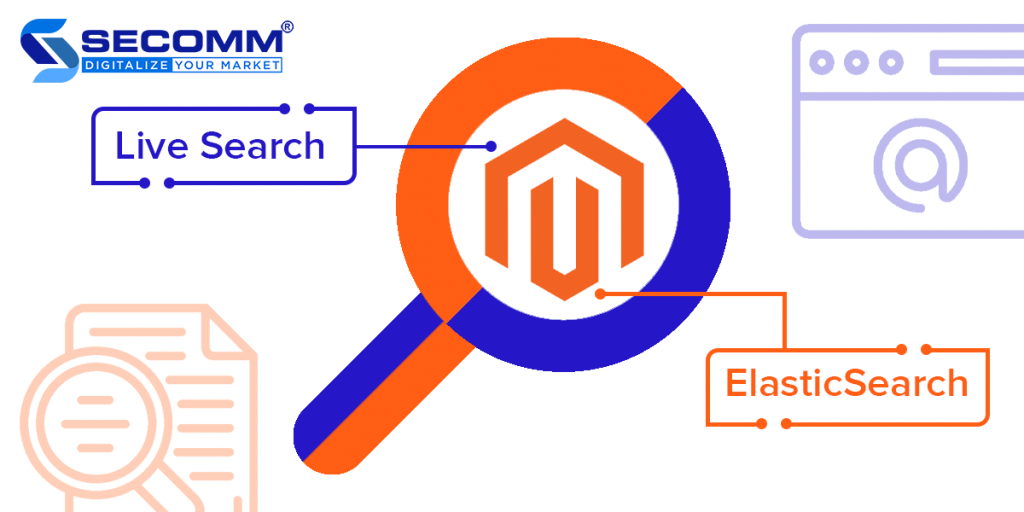
Live Search combines artificial intelligence (AI) and machine learning (Adobe Sensei) to provide fast search results and personalized product recommendations based on customer behavior, trends, characteristics, and other data.
ElasticSearch is an open-source distribution that supports enterprise-level search engines for searching data on the server. This function aims to perform real-time analysis and data source mining (MS SQL, MySQL, PostgreSQL, etc) to optimize highly for fast language-based searches.
Simultaneously, overcome the difficulties by hiding all other complex operations by providing API access.
This function includes a variety of actions, such as the ability to drag and drop content on the website to provide the best user experience, preview how the content will appear on the user interface, and modify forms to enter and customize content.
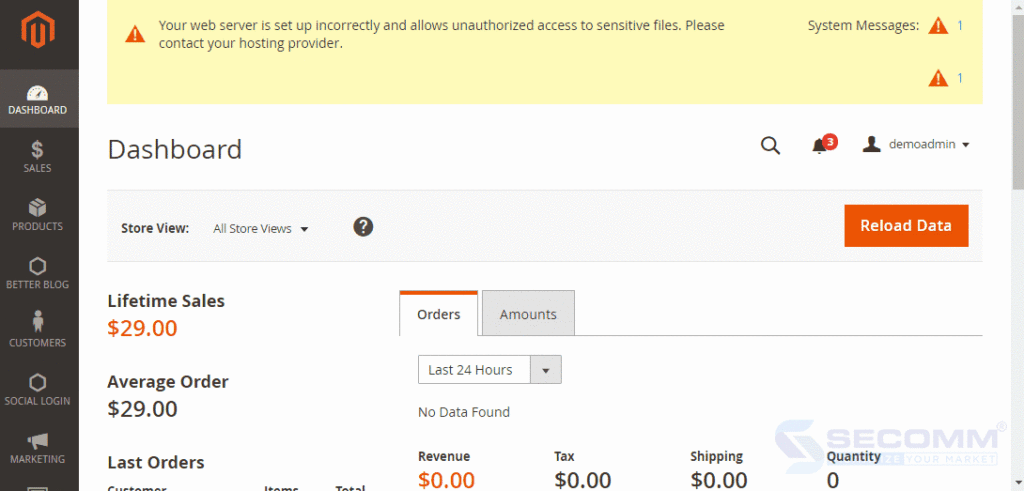
Initially, Magento’s functionality only supported the Magento Commerce version (Magento Enterprise Edition). Still, since Magento 2, the developer has supported the Magento Open Source version, allowing businesses to create unlimited CMS content pages.
Magento’s high security has long been a distinguishing feature that makes it the preferred platform for businesses.

Using a periodic security scanning tool to quickly identify problems and update patches and notifications, propose security solutions to deal with arising errors, and effectively improve and optimize website security.
To increase the level of security for administrator accounts, use advanced passwords. The administrator password should be at least seven characters long and contain letters, numbers, and special symbols. Password complexity may be increased with lower case/case sensitivity, or re-login may be required after a certain length of a login session, depending on additional adjustments.
CAPTCHA security can protect both administrators and website visitors. In addition, using CAPTCHA aids the system in preventing bot spam and malicious code from entering the system illegally.
The 2FA (Two-Factor Authentication) function provides additional security for system user accounts. To effectively limit threats of unauthorized access and attack on user accounts, customers must authenticate with an OTP security code sent to their phone number after logging in.
PWA combines a website and a native app (for Android and iOS) on tablets and smartphones. Therefore, PWA enables your website to function and interact with mobile users in the same way that a native app would.

However, depending on the user’s needs, this website can be converted into a mobile application right on the device. Users can download the app to their phones when they visit the website. If the user agrees, they can open and browse the website in the same way they would an app on their phone.
SEO is another fantastic feature of Magento, in addition to optimizing website content, this feature also searches for indexed pages and assesses the SEO quality of each page. From there, the business website can use the robots.txt file to prevent the crawling of low-value parameters and consider only indexing pages with high search potential to improve rankings.
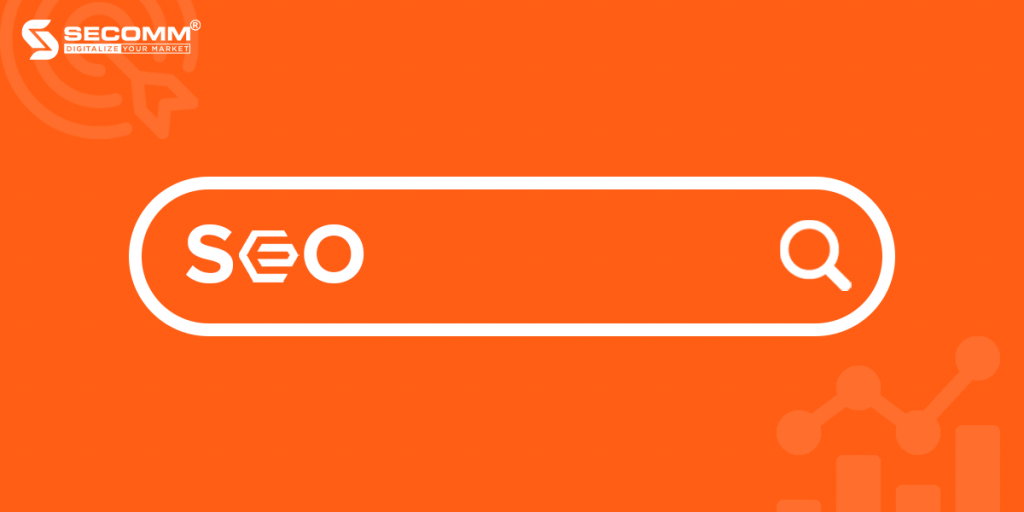
In addition, Magento has many other features such as cross-device compatibility, quick purchase and quick checkout, and so on. However, the development cost of an e-commerce website with such complex features is often very high, ranging from $5,000 to $100,000.Businesses should think about their e-commerce strategy when developing a unified sub-feature system.
With extensive experience developing many complex e-commerce systems on Magento, SECOMM understands the challenges that businesses face when selecting a platform and implementing E-commerce.
Contact SECOMM for a free consultation on comprehensive e-commerce system development solutions!
 2
2
 6,348
6,348
 1
1
 1
1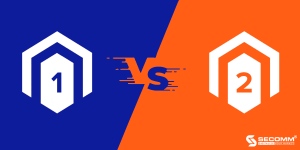
Magento is a specialized open-source platform for creating the most popular eCommerce websites today.
Currently, it supports two versions: Magento 1 and Magento 2. Some websites use M1 platform, such as CellphoneS, and Bach Long Mobile (Magento Open Source 1.9). Websites using M2 such as Di Dong Viet, and Kidsplaza (Magento Open Source 2.3).
So what is the difference between the two versions, and why have businesses not upgraded their websites to M2?
M2 uses newer technologies than M1, resulting in more diverse performance, user experience, and functionality.
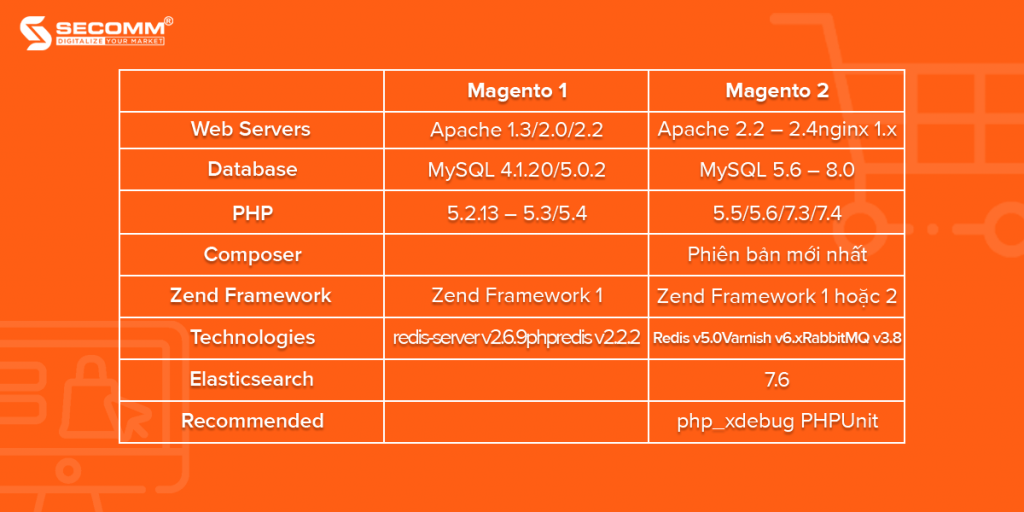
Both platforms support a wide range of third-party extensions. However, many utilities on M1 will frequently repeat a piece of code, causing conflicts for the website’s functional system, and requiring a significant amount of time to manually fix it. Meanwhile, Magento 2 has supported a plugin that allows code to overlap, assisting in the issue’s faster and more effective resolution.
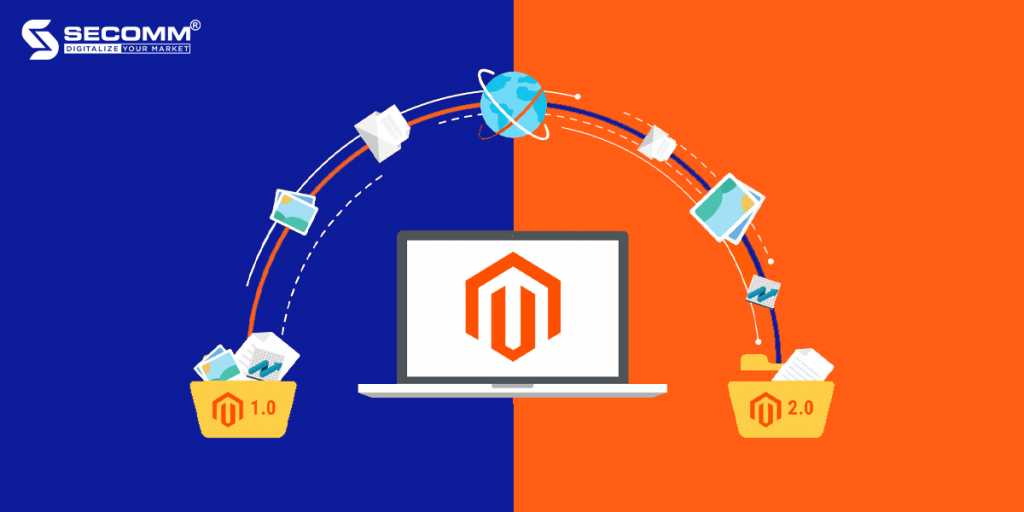
At the same time, M2 support utilities frequently use new technologies (HTML5, CSS3, Requirejs) at lower prices. Compared to M1, this makes it easier for developers to customize, upgrade, and build new functionality for the website.
Magento 1 is frequently criticized for having a messy admin interface that takes a long time to adapt. In contrast, Magento 2 is more user-friendly for admin accounts because:
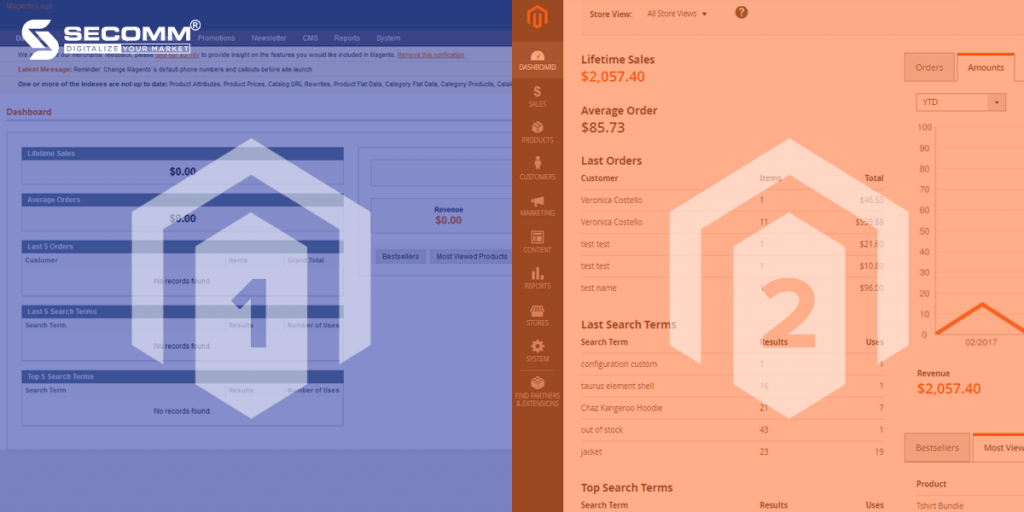
Magento has long been known for its SEO capabilities, but developers can improve SEO even better with Magento 2:
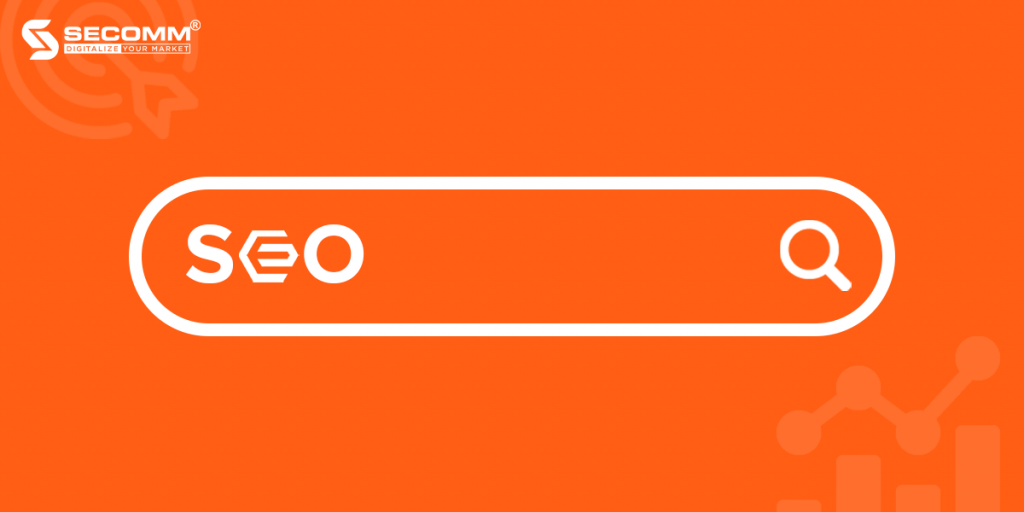
Since June 2020, Magento has stopped updating and releasing security patches and fixes for M1. Therefore, M1 websites easily become a target for cyber attacks.
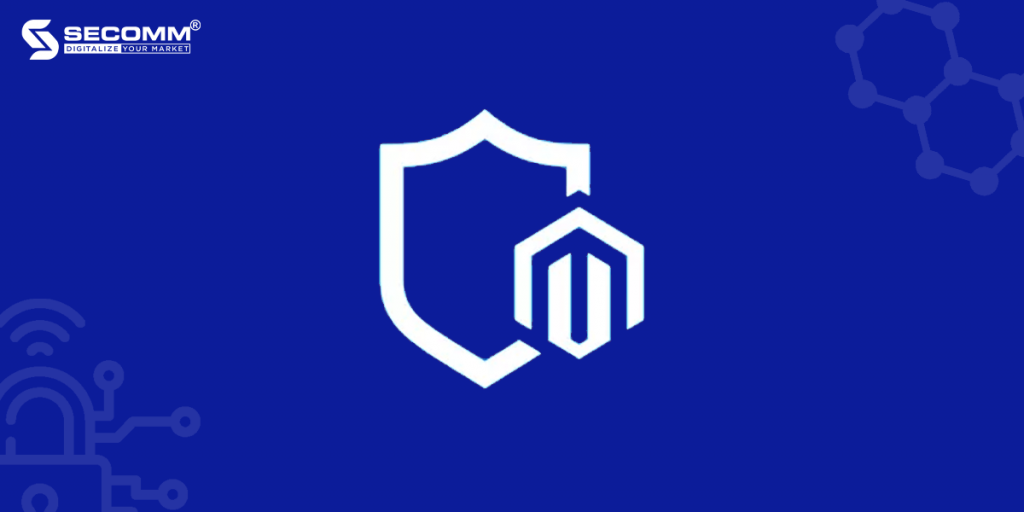
Meanwhile, the publisher continuously updates M2 to increase the system’s security. For example
M1 continues to meet enterprise eCommerce systems’ interface, functional systems, and management system requirements. As a result, businesses continue to use M1 rather than upgrading to M2. At the same time, the Magento technical community continues to support the utilities for M1 enthusiastically.
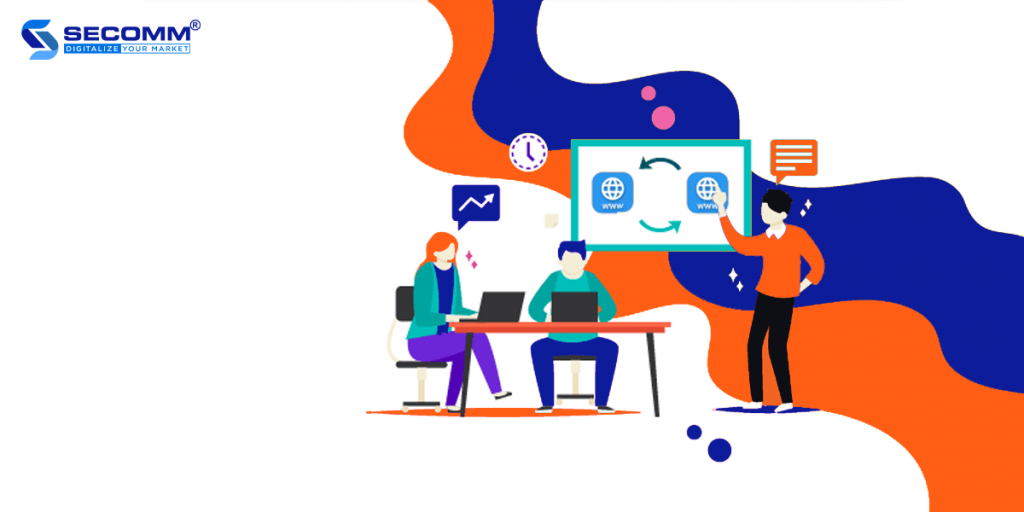
Although Magento 2 provides many improved utilities, its technologies are still relatively new for many companies, particularly those in countries that have lagged behind eCommerce market growth.
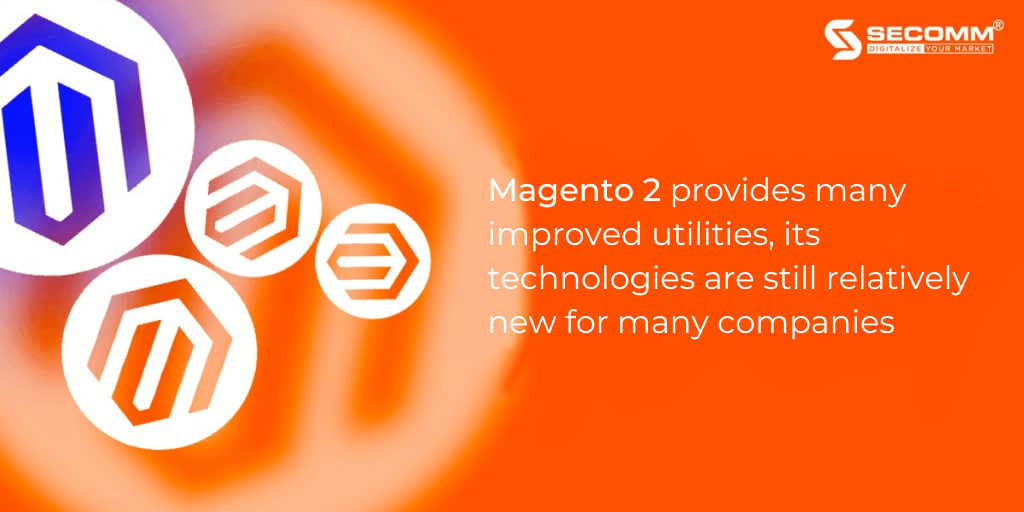
Upgrading from M1 to M2 is difficult because the technology infrastructure is entirely different between the two versions. As a result, website developers will require a significant amount of time to migrate all functions and data from M1 to M2, ranging from 1 to 3 months on average.
In addition, businesses require a technical team with expertise in new technologies to manage the system and efficiently upgrade the website. As a result, the upgrade costs more, ranging from $5,000 to $10,000 or more, depending on the system’s complexity.
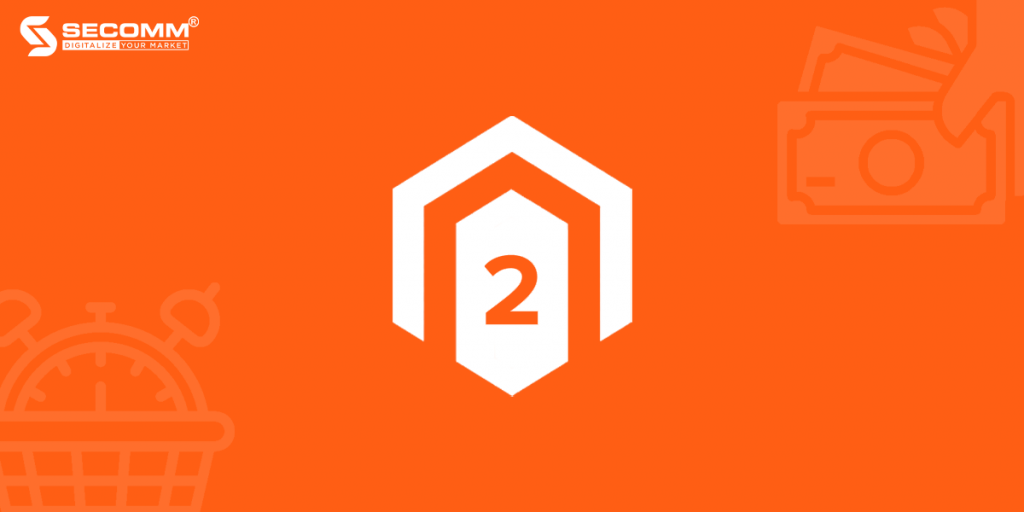
Although M2 outperforms M1 in every way, many businesses are hesitant to upgrade their websites to M2 due to various issues. However, upgrading the website to M2 is unavoidable in the long run due to the growing gap between the two versions.
Our company – SECOMM, has been partnering with many big enterprises such as An Nam Group (Vietnam), Jasnor (Australia), and Changi Airport Group (Singapore). As a result, we are aware of the challenges and worries firms face while developing an eCommerce website system as well as upgrading their websites from M1 to M2.
Get in touch with us now for FREE eCommerce development consultancy and solutions
 2
2
 4,147
4,147
 0
0
 1
1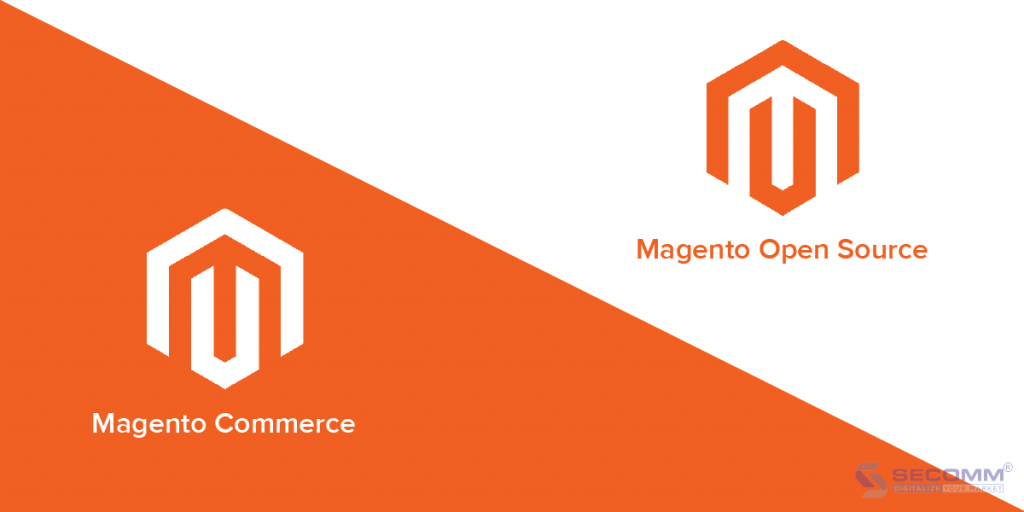
With over 200,000 websites worldwide, Magento is today’s most widely used eCommerce platform. Magento is always the best choice for businesses to use because of the benefits of open source code and specialized features for the eCommerce market.
Businesses must carefully study the strategy and consider the needs of the website system when deciding between Magento Open Source and Magento Commerce to implement eCommerce on the Magento platform.
Magento Open Source was initially known as Magento Community Edition (CE), a free version of the Magento open source platform. This version provides a flexible framework for building eCommerce websites, which is popular among many businesses.
.
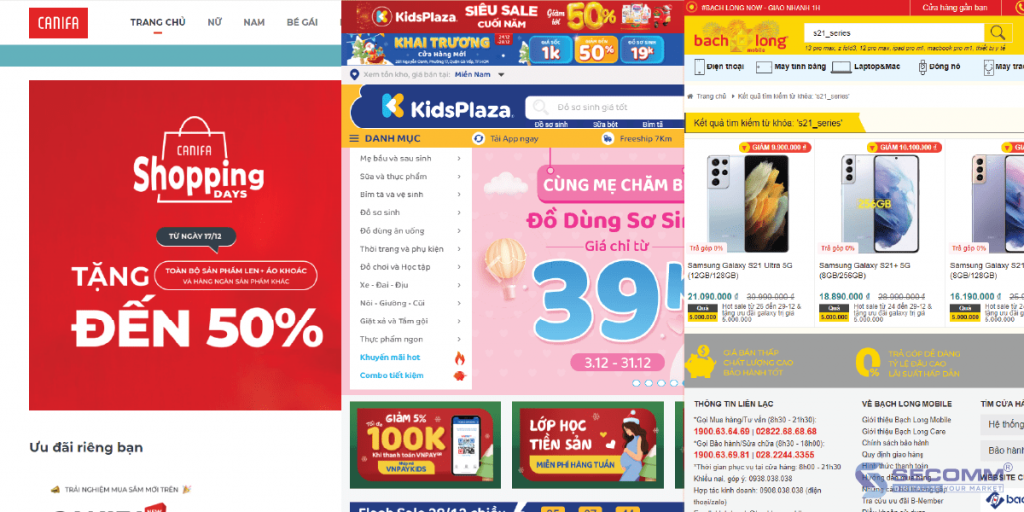
Magento Commerce, formerly known as Magento Enterprise Edition (EE), is a website system used by large businesses with complex website system requirements.
This instance provides an on-premises solution as well as a hosted solution as a service (Magento Commerce Cloud), which aids in website performance and user experience. As a result, the annual fee for using this version is $24.000.

The platform will charge an additional $2.000/year for the included hosting service when using Magento Commerce to ensure that the business’s website system is constantly updated and upgraded, allowing it to handle high traffic and bills of lading more quickly.
Meanwhile, Magento Open Source is free to select a hosting provider that meets the business’s requirements and budget.
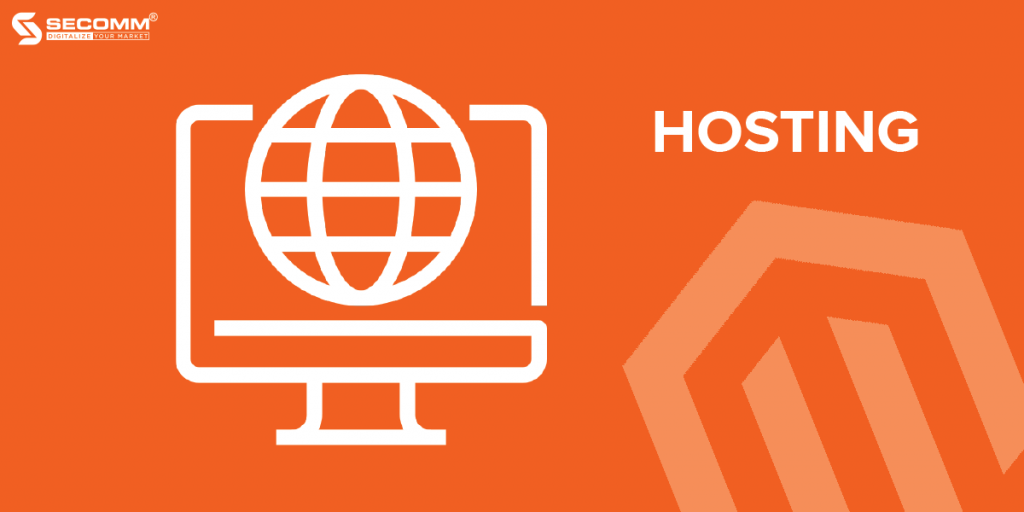
The following table compares the features that distinguish the two versions of Magento:
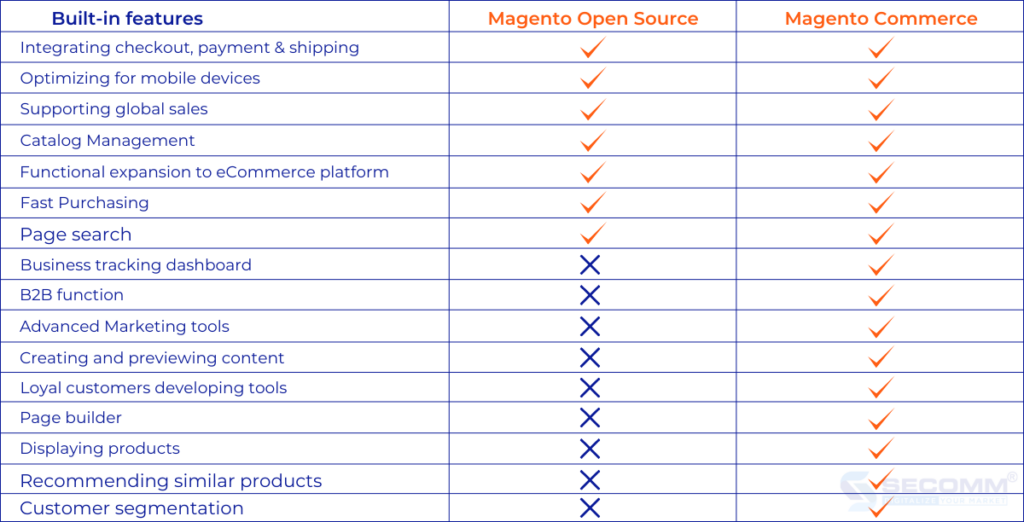
Magento Open Source has fewer features than Magento Commerce because it is a free version. Businesses, on the other hand, businesses can build the necessary functions themselves using extensions from the Magento ecosystem, the community of extension developers, or the project developers with whom Magento collaborates.
Magento Open Source will require a lower investment than Magento Commerce, from hosting and domains to website development. Nevertheless, the technology infrastructure is the same, so the costs of interfaces and extensions are calculated similarly.
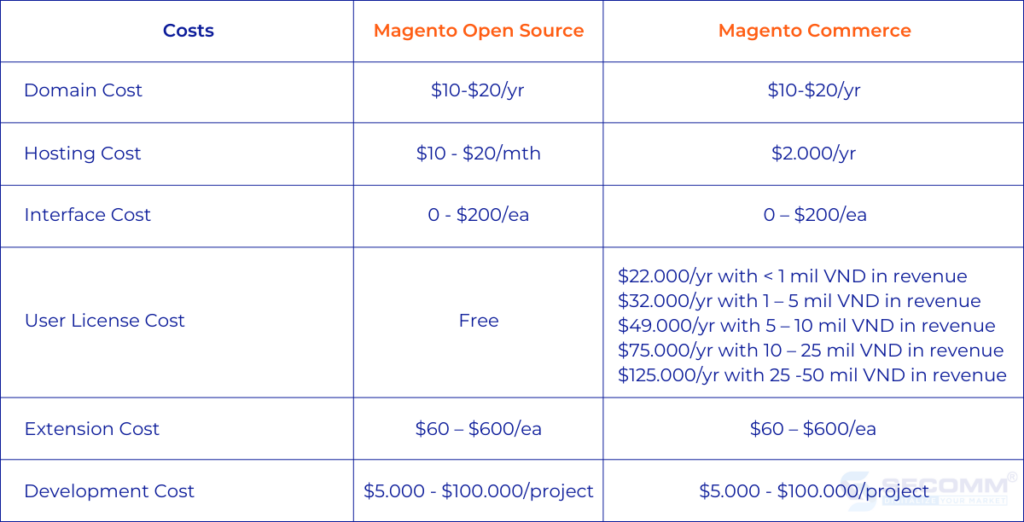
While Magento Commerce provides global technical support, including cloud service integration, Magento Open Source is not directly supported by the Magento technical team. However, the current Magento Open Source website developers continue to ensure expertise so that the business website is constantly updated and effectively operated.
Magento Open Source will be ideal for startups, SMEs (small and medium enterprises), businesses new to eCommerce, and even large corporations that do not yet require Magento Commerce’s advanced functionality system. Because using Magento Open Source is advantageous:
Meanwhile, Magento Commerce will be appropriate for large businesses because:

Choosing the best Magento version will be determined by each company’s long-term eCommerce strategy. However, it is also critical to implement those versions. They must collaborate with professional Magento developers to consult on and implement the best eCommerce solution.
With in-depth experience and developing many complex eCommerce systems on Magento, SECOMM understands the obstacles in choosing a platform and implementing Ecommerce businesses face.
Get in touch with us now for FREE eCommerce development consultancy and solutions
 2
2
 7,560
7,560
 0
0
 1
1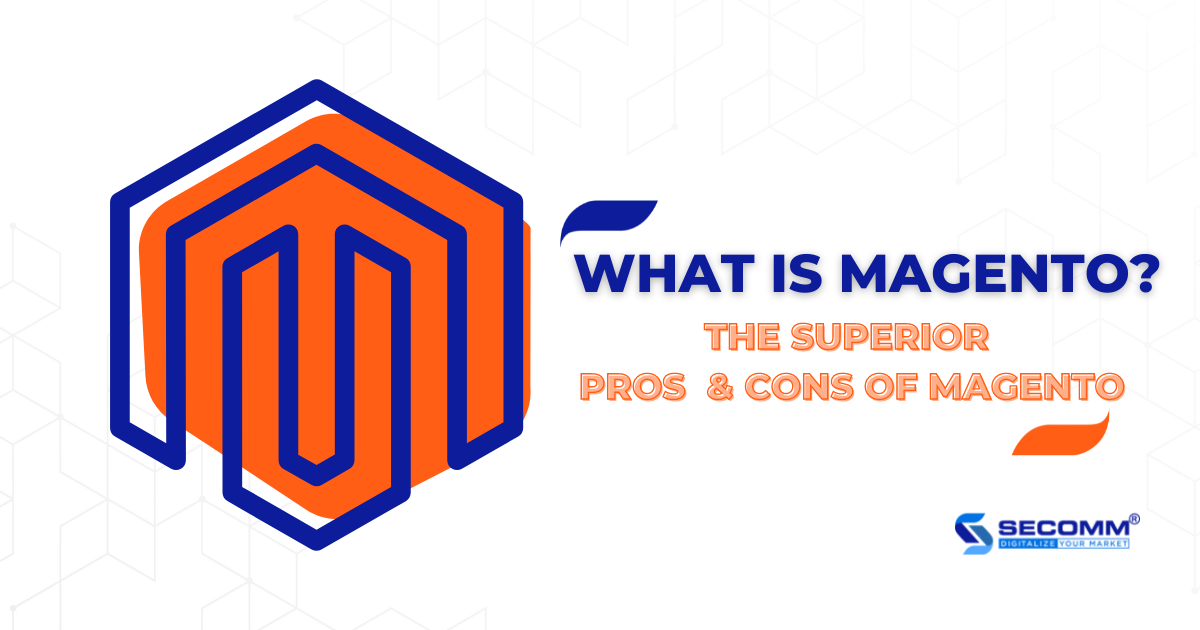
Along with the eCommerce market growth comes an increase in business demand for a separate eCommerce website system to maximize online business.
The platform’s role in developing and operating an effective eCommerce website system is enormous because choosing the right platform will help businesses save time in building a team, saving system development costs, reaching potential customers, boosting sales, and seizing long-term sustainable development opportunities.
Among today’s popular platforms such as Shopify, BigCommerce, WooCommerce, and others, Magento is widely regarded as the best platform for developing eCommerce websites, with over 186,000 websites in use worldwide.
This is an open-source platform designed specifically for the eCommerce industry. In addition, it is the most challenging source code platform in the PHP programming language. As a result, Magento can handle a company’s specialized needs in a constantly changing and evolving market like eCommerce.
Many major brands and corporations, including HP, Asus, Puma, and Walmart, have used the platform. In addition, some famous brands in Vietnam use Magento websites, including CellphoneS, Vua Nem, Kids Plaza, Mobile Viet, and so on.

Magento currently offers two versions: Magento Open Source and Magento Commerce.
Magento Open Source was initially called Magento Community Edition, a free version of Magento. This version provides a “framework” to build eCommerce websites flexibly, so it is very popular with many businesses.
Some websites use Magento Open Source in Vietnam, such as Canifa, Kids Plaza, Bach Long Mobile, etc.
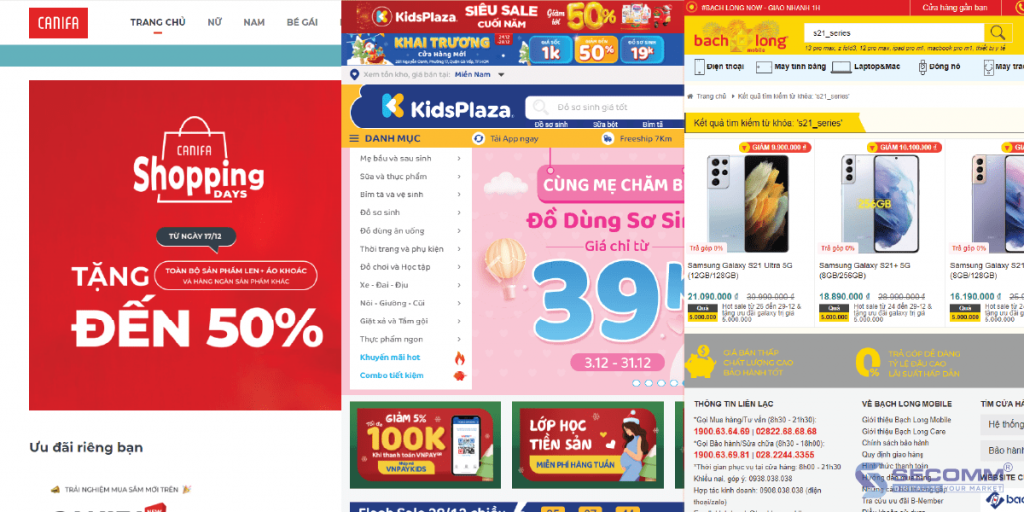
Magento Commerce was previously known as Magento Enterprise Edition. This version is appropriate for significant businesses that require a website system with complex functions.
In addition, this edition provides an on-premises or a hosted solution as a service (Magento Commerce Cloud), which aids in website performance. The minimum fee for using this version is $24,000 per year.
The brands using Magento Commerce in Vietnam are CGV, Bibo Mart, Rohto, etc.
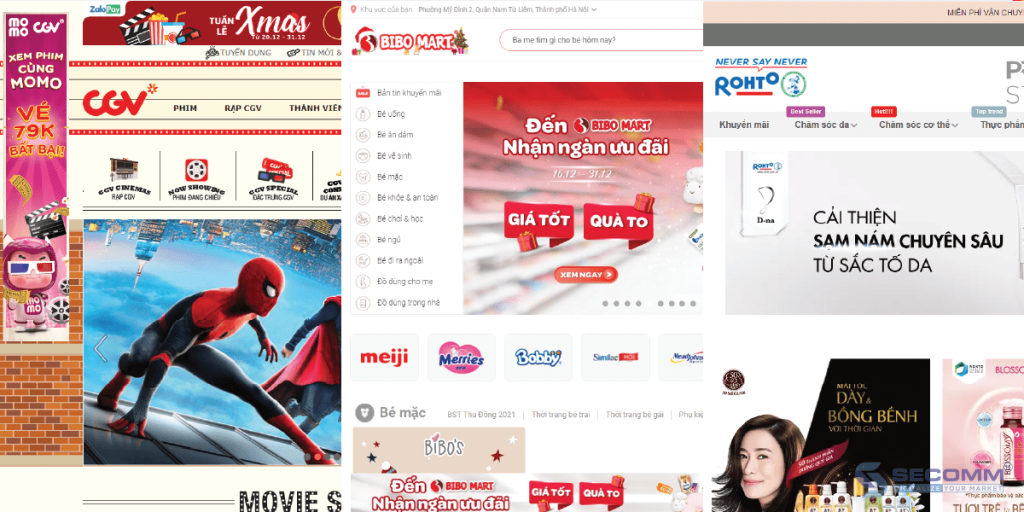
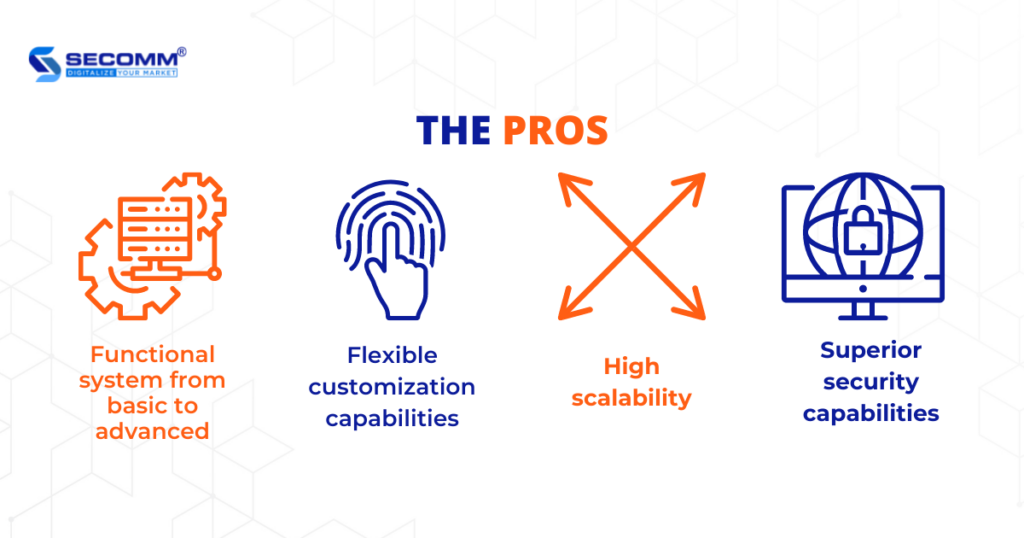
Magento includes all of the features required for a complete eCommerce website, including category management, content management, sales management, marketing management, and customer management, as well as analysis and reporting.
In addition, Magento owns many extensions with advanced features such as Headless Commerce, PWA (Progressive Web Apps), MSI (Multi-Source Inventory), ElasticSearch, etc to meet all eCommerce needs for businesses.
Furthermore, Magento has a global technical support community comprised of many experienced experts and professional development units to assist with meeting all business requirements.
Magento possesses all the advantages of an open-source platform with flexible customization capabilities. Owning and controlling the entire source code, in particular, allows businesses to customize parts of the code in the system, easily update, or even develop new functions based on each business specificity.
In addition to customizing, Magento also has very useful website scalability. Magento allows businesses to scale from one website to many websites, one store to many stores, but the management is still on the same system. Besides, Magento supports multi-language and currency conversion, helping businesses expand globally.
Magento’s high security is also an outstanding advantage, with the ability to control the system regularly, propose security solutions, improve security for administrators, and prevent bots or unauthorized malware, among other things. As a result, this platform assists businesses in reducing potential risks associated with the data and transaction processes.
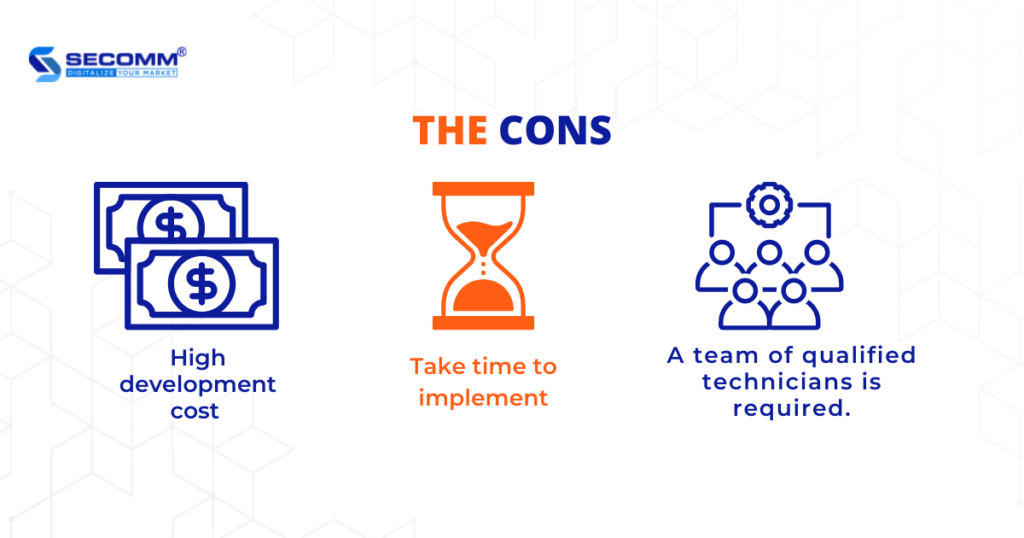
The cost of owning a Magento website is high due to its many outstanding benefits, such as the functional system, customizability, scalability, and good security. However, depending on the system’s complexity, a website built on the Magento platform costs between $10.000 and $100.000.
A comprehensive Magento project requires implementation time ranging from 3 months to 1 year. A complete Magento project requires implementation time ranging from 3 months to 1 year. As a result, it slows down businesses’ digital transformation processes and makes it difficult for them to keep up with competitors’ development rates and market trends.
Businesses require a technical team with high expertise and experience with the Magento platform to build and operate an intensive eCommerce website system customized to the unique characteristics of each product and category.
As a whole, Magento is an eCommerce platform that is appropriate for all types of businesses, including startups, SMEs (small and medium enterprises), and large corporations. However, budget, time, and professional team issues have caused many SMEs businesses to be hesitant to use Magento to develop eCommerce websites. That is why Magento frequently be used in large corporations to build complex eCommerce systems.
Our company – SECOMM, has been partnering with many big enterprises such as An Nam Group (Vietnam), Jasnor (Australia), and Changi Airport Group (Singapore). As a result, we are aware of the challenges and worries firms face while developing an eCommerce website system.
Contact SECOMM now for a free consultation on detailed eCommerce system development solutions!
 2
2
 5,015
5,015
 0
0
 1
1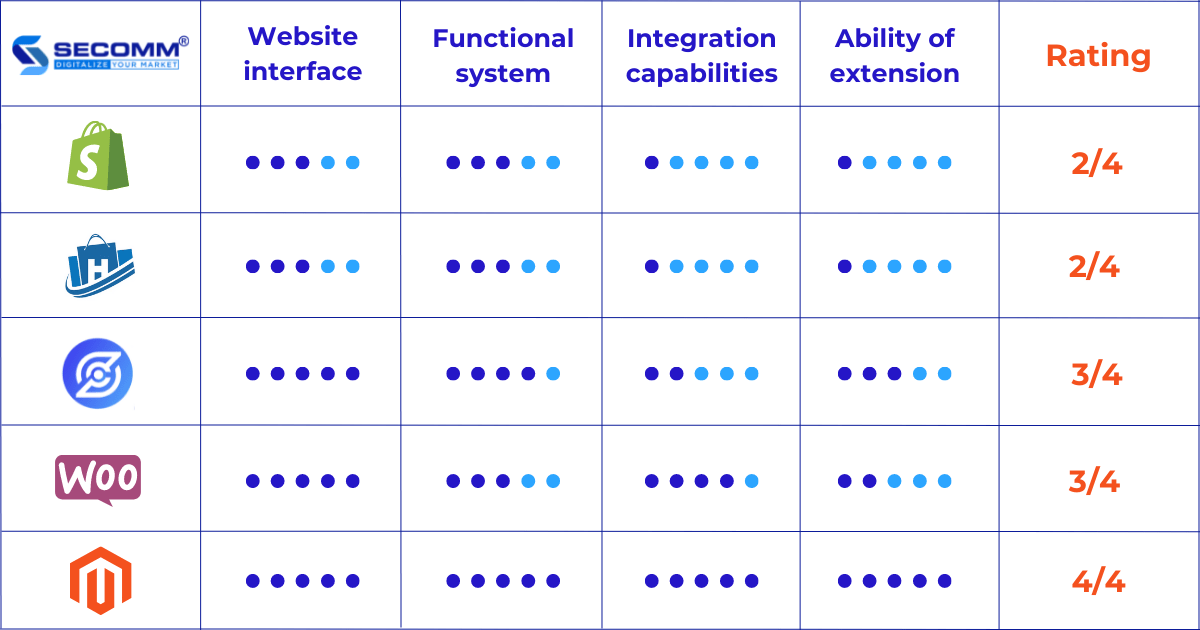
With the boom in recent years, ecommerce is a potential business form pursued by many businesses, especially egrocery stores. According to Statista, the grocery ecommerce market in the United States is likely to exceed $24 billion by 2023.
Realizing the potential of the egrocery market, several businesses have deployed grocery ecommerce websites early and experienced breakthrough growth, such as Grofers (Blinkit) and BigBasket in India, Bach Hoa Xanh, An Nam Gourmet, Farmer’s Market, WinMart, and Organica in Vietnam.
The common thing that makes the success of the above brands lies in the ecommerce platform. Therefore, to develop and operate an effective ecommerce website, the role of platforms is enormous.
So which ecommerce platforms are suitable for the grocery industry?
For the website interface, in addition to meeting basic needs such as UI/UX standards and showing the brand’s characteristics and the eGrocery industry, businesses also need to focus on the presented product images. Therefore, on the website, everything needs to be synchronized and precise.
The administrator interface (admin) must be easy to use, navigate, control, and manage all data in the system.
With eGrocery, the system of ecommerce features needs to be diverse from basic to advanced, solving complex characteristics of the grocery industry such as products with multiple units, weight difference, and price volatility, export-import complex warehouse, and synchronized data throughout the system.
Some functions required in a grocery ecommerce website system such as:
To have a seamless online volatility store system with multiple sales channels, businesses must integrate their ecommerce website with other payment services, shipping services, management software, analysis, report, and distribution systems:
This integration helps businesses overcome the limitations of the “rice-powered” process, increase the automation of the system, limit business mistakes, and ensure high accuracy and performance.
To accompany businesses to develop over time, from startups, and SMEs (small and medium enterprises), to large corporations, from B2B, B2C, and D2C business models to B2B2C, commerce electronics platforms must be highly scalable. High scalability helps meet all future business growth needs, such as multi-site, multi-country, and multi-currency, all manageable on “one screen.” Not only that, but highly scalable platforms also support businesses to operate the system stably regardless of the traffic in promotion campaigns.
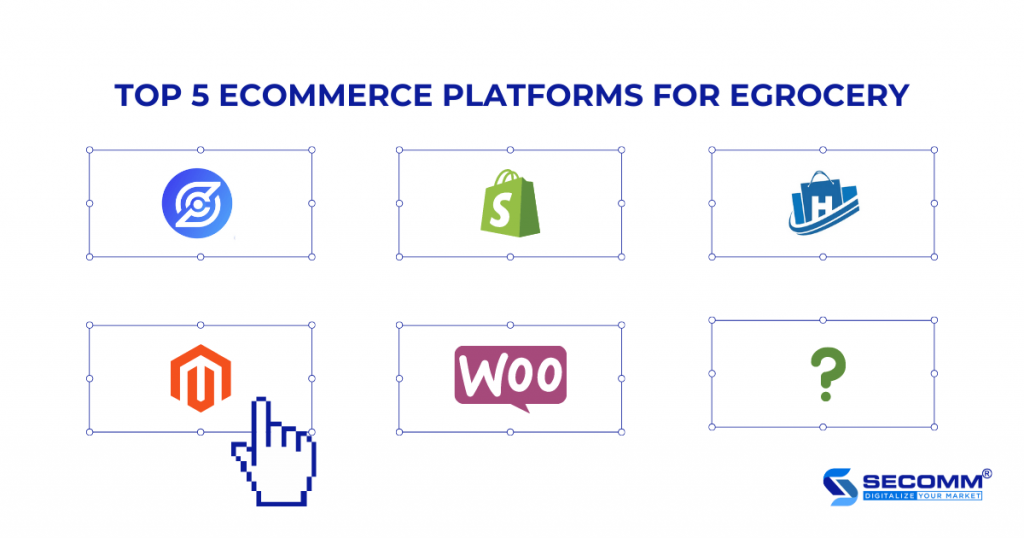
Ziel Commerce is a readymade grocery ecommerce platform with all the features designed to support an online grocery store business.

Ziel Commerce provides a repository of themes specifically for the grocery industry, allowing businesses to customize according to their needs, helping to both reflect the characteristics of the industry and position the brand image.
Remarkably, the interface for administrators is also invested by the founders to make it most accessible for businesses to use. But currently, Ziel Commerce is not popular in the Vietnamese market, so there is no Vietnamese version for businesses.
As a platform designed specifically for the eGrocery industry, Ziel Commerce can meet all the most specialized needs of businesses, including fundamental to advanced functionality systems and existing industry-specific solutions.
Ziel Commerce has a significant drawback in integrating the website system. In addition, this platform only supports add-ons available in its ecosystem, so businesses will not be able to link with the ERP, POS, CRM, BI, etc., systems in use. Therefore, when using Ziel Commerce, companies need to transfer all existing data to the server of this platform.
Although it does not own the source code, Ziel Commerce is still a highly appreciated platform for its scalability compared to SaaS platforms. Ziel Commerce supports businesses to expand their ecommerce website system from one to many stores/websites, multi-language, multi-currency without many obstacles. However, in the long run, Ziel Commerce cannot support businesses to expand or develop new functions because firms cannot affect the source code; if it affects it, it will cause instability for the commercial website system.
→ Rating: 3/4
Ziel Commerce provides an almost comprehensive online grocery store website building solution for businesses, from website interface and functional system to scalability. However, the implementation cost is relatively high, about $50,000/project in 6 months. Therefore, Ziel Commerce is only popular with retail chains, has high functional demand, and operates mainly abroad. However, when using Ziel Commerce, businesses should consider adding the platform’s integration, limiting instability in the operation when 3rd party systems are not compatible with the platform.
Shopify is a SaaS ecommerce platform favored by the international ecommerce business community because of its fast implementation time and reasonable starting cost.
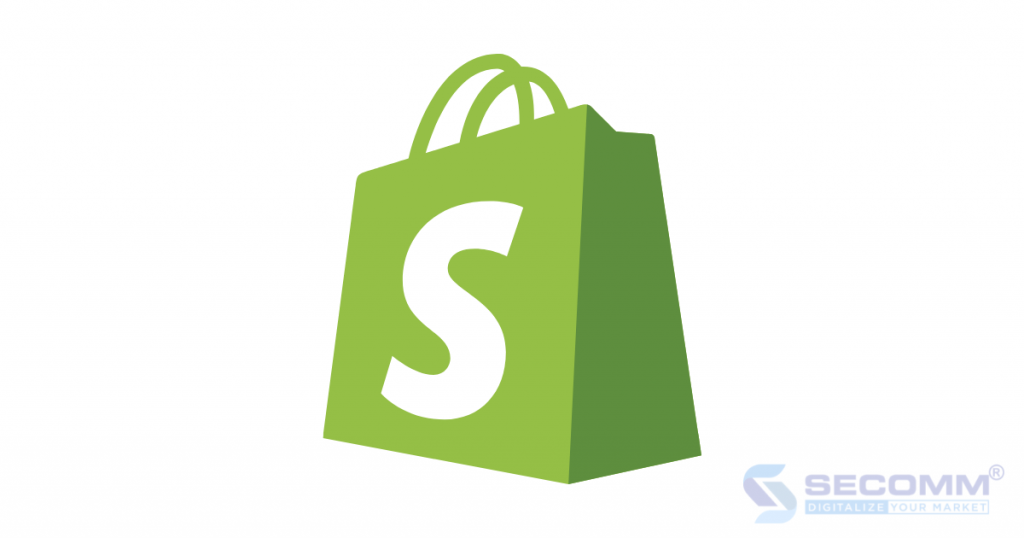
Shopify provides a variety of interfaces, including grocery industry and UI/UX standards, but cannot be edited according to the characteristics of the business.
Shopify’s functional system is relatively complete, meeting the basic needs of businesses. But to use advanced functions, companies have to pay a certain amount of money every month, leading to an increased cost of using the functional system. In addition, even Shopify can barely provide eGrocery industry-specific resolution functions.
Because it is a SaaS platform, businesses cannot affect the source code, and it is not easy to integrate with many 3rd parties. Companies can only integrate utilities provided by Shopify or a platform partner.
Some utilities that companies can integrate with Shopify include:
Similar to the ability to integrate, the scalability on Shopify is not high because businesses cannot influence the source code to edit and upgrade the website. Therefore, online grocery businesses can only use Shopify for the first time.
→ Rating: 2/4
Shopify is only suitable for businesses new to the ecommerce market, startups, or SMEs (small and medium enterprises) because of the reasonable development cost and time to deploy an online grocery store business website.
Founded in 2014, Haravan is an ecommerce platform based on Shopify. Currently, Haravan is a popular platform in the Vietnamese market with more than 50,000 business people and trusted brands.
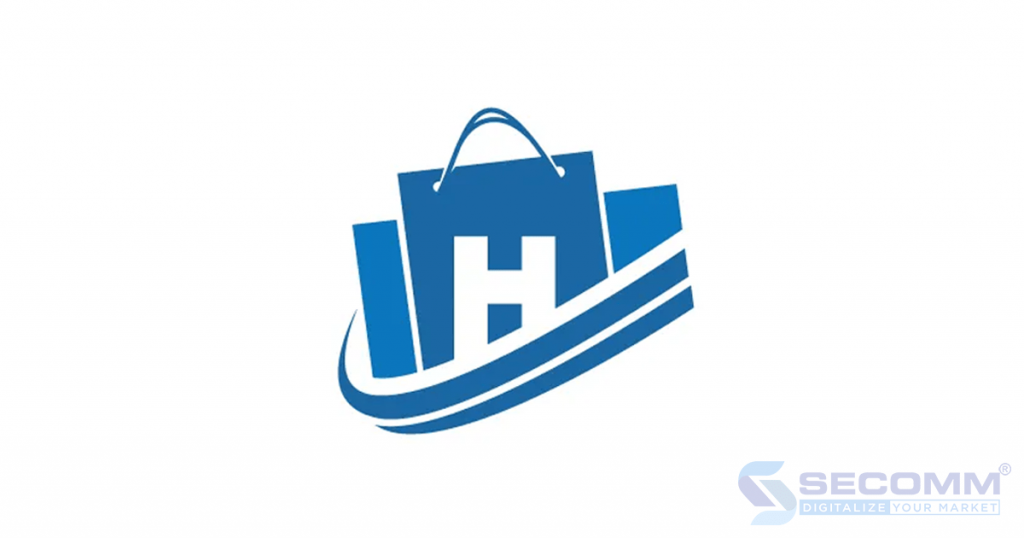
Haravan has many standard UI/UX interfaces suitable for the grocery industry, including free and paid. At the same time, the interface for administrators supports Vietnamese and is easy to use, so businesses do not face many difficulties when using it.
Haravan provides many utilities – functions for online grocery stores in Vietnam.
In addition, similar to Shopify, to use more advanced functions, businesses have to pay a monthly application fee of about 100,000 VND/month/app.
However, businesses can’t find parts that deal with the grocery’s specifics in Haravan’s app store and can’t develop in terms of specific functions. Enterprises can only use the functions included in the package and app store.
For integration capabilities, Haravan can integrate with Haravan’s partners such as transportation (Economic Delivery, Fast Delivery, Ahamove, GrabExpress, etc.), payment (Ngan Luong, VNPAY, Napas, PayPal, etc.), etc.).
It is difficult for businesses to integrate for 3rd party utilities outside Haravan’s ecosystem on their ecommerce website.
As for the extension of the ecommerce website system, Haravan can only support the multi-language – currency but cannot expand from one to many websites/stores. It is challenging to manage all the data on a foundation.
As the business gradually grows and expands, Haravan will no longer be functional enough to maintain an online grocery store business. As a result, companies are forced to switch to more specialized platforms such as Magento, WooCommerce, and OpenCart. But, of course, switching platforms will create many other problems such as costs, time, personnel, etc.
→ Rating: 2/4
Similar to Shopify, Haravan is only suitable for businesses new to the ecommerce market, startups, and SMEs. But Shopify can support online grocery business globally, and Haravan only stops at the Vietnamese market.
WooCommerce is an open-source platform in the form of a WordPress plugin, allowing businesses to use it completely free.
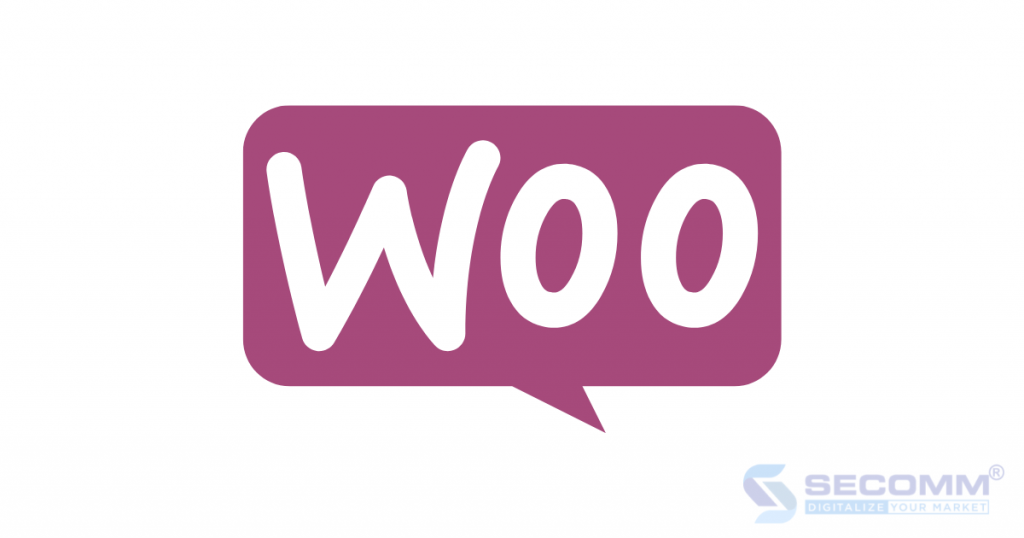
WooCommerce and the community provide businesses with various themes designed for the grocery industry. At the same time, this platform also allows influencing the source code to customize according to needs, helping businesses quickly convey brand messages and images.
Since WooCommerce is a WordPress plugin, the admin will continue to manage the website on the WordPress interface itself. This makes it easy for businesses using WordPress to adapt, use, and navigate on the WooCommerce dashboard.
WooCommerce supports a variety of features, from basic to advanced. However, this platform has some limitations on features specific to the grocery industry because interfering with developing these functions will easily cause instability for the website system.
Thanks to the advantages of the open source platform, WooCommerce has flexible customization capabilities and supports integration with many 3rd party utilities.
In payment, businesses can use amount plugins such as Stripe, PayPal, Apple Pay, and Square to their ecommerce website system with high security and safety. In addition, companies can integrate with many shipping providers such as Fedex, Ups, USPS, and DHL Express. The WooCommerce platform also allows businesses to integrate with management software such as Odoo, Square POS, WP ERP, and Marketing software such as Google Listings, Google Ads, and Facebook Pixel to support businesses in effective business management. More fruitful.
Contrary to the integration capabilities, the extensibility of WooCommerce is not appreciated. Because the system is easily overloaded with plugin themes, and the number of products does not exceed 2000 SKUs (Stock Keeping Unit). Therefore, businesses wishing to expand their website system need to consider when using this platform in the long run.
→ Rating: 3/4
WooCommerce is the right platform for grocery businesses that use WordPress and are looking to develop an ecommerce system. But when using WooCommerce, companies should consider the limitations of integration, extensibility, and customizability of specific features.
Magento is a popular open source commerce platform in ecommerce, with nearly 200,000 websites in use. Currently, Magento has 2 versions: Magento Open Source (free) and Magento Commerce (paid).
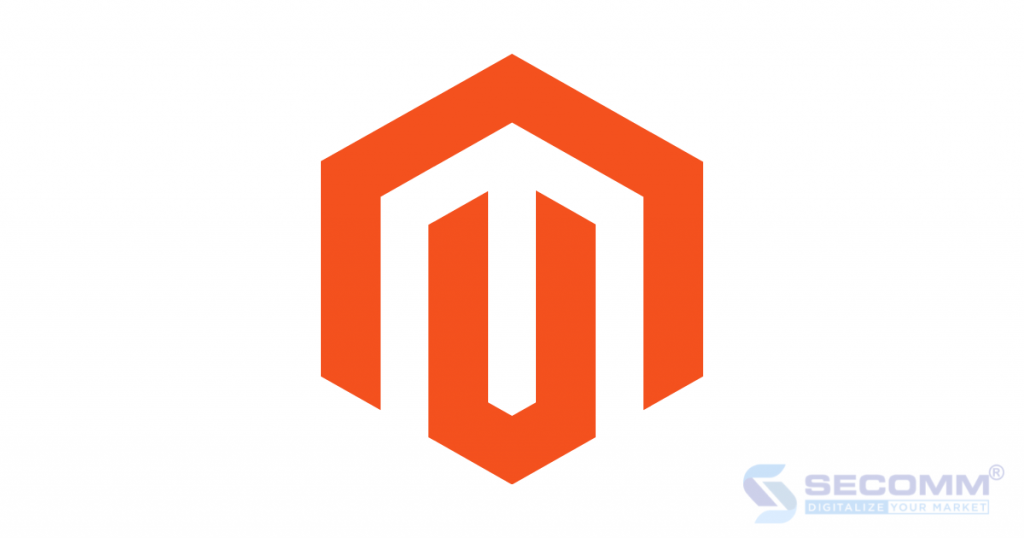
Although Magento does not own a rich theme store like other ecommerce platforms, businesses can look to the developer community, market (Envato), or design their own. Having many options when designing the interface helps Magento websites to have their uniqueness, avoid overlapping the interface with many different websites and bring a higher shopping experience.
Previously, the admin interface on Magento 1 was often considered difficult to use and took a long time to adapt. As a result, Magento publishers developed Magento 2 with a more intuitive and easy-to-navigate dashboard to overcome this problem.
The Magento platform has a highly diverse system of features from basic and advanced to industry-specific to help grocery businesses quickly build and develop a sustainable system.
A basic functional system, including catalog management, product management, customer management, report analysis, etc., helps meet the basic needs of a convenient online grocery store business.
In particular, Magento also has many advanced functions for ecommerce, such as multi-language support, multi-currency, multi-store, PWA, MSI, ElasticSearch, etc. Shopping happens faster.
Magento does not have built-in features only for the grocery industry regarding specific features. Still, businesses can quickly build a system of particular features such as category classification, quick search, and delivery time selection thanks to flexible customization on open source code.
Thanks to the advantages of the open source platform, the Magento website can be easily integrated with any 3rd party utilities, from payment, shipping, and business administration.
Regarding payment, Magento easily connects with today’s popular payment methods such as card payments (domestic cards, VISA, Mastercard), e-wallets (MOMO, Zalopay), and payment gateways (OnePay, VNPay, etc.) PayPal) or COD, which helps to diversify payment methods.
Magento can integrate with shipping providers such as Fast Delivery, Economy Delivery, Viettel Post, and order tracking applications.
Magento can be integrated into back-office management software (ERP, CRM, POS) such as SAP, Salesforce, and Oracle to help operate all resources and processes seamlessly in the enterprise.
In addition, Magento also supports integration with business analysis tools such as Power BI, Tableau, and Looker and analysis and reporting utilities such as Google Analytics, Google Tag Manager, and Facebook Pixels to exploit all data from the system. As a result, Magento plans to improve its business strategy.
Magento allows businesses to expand from one website to many different websites on the same system to meet the needs of business development. In addition, with the available support for language and currency conversion from Magento, businesses can build a grocery ecommerce system with content suitable for a diverse audience of customers around the globe.
In addition, open source customization enables Magento developers to build functional solutions specific to the grocery industry. This advantage makes Magento expand the system of capabilities according to each business size, from small businesses to large-scale corporations.
→ Rating: 4/4
Because Magento possesses many outstanding advantages, from website interface and functional system to the ability to integrate and expand, Magento is suitable for a variety of grocery business models from B2B, B2C to B2B2C, a multiform of enterprise-scale such as startup, SME, enterprise (large corporation). However, the time to deploy ecommerce on Magento is usually long – from 6 months to 1 year, with high construction costs of about 50,000 – 100,000 USD/project. At the same time, businesses also need to have a professional team or cooperate with experienced units to develop an effective grocery ecommerce system. Therefore, Magento is popularly used in the community of large-scale businesses that need many functions to increase user experience.

Choosing the right platform is the first and most significant step when building a grocery ecommerce website. Selecting the right ecommerce platform will help businesses save budget and time in building a website while increasing competitive advantage and sustainable growth. On the contrary, choosing the wrong forum will cost businesses a lot of time and budget to deploy and switch platforms. Therefore, companies need to consider the goals and problems in the current model to choose the most suitable platform.
With experience in successfully implementing complex grocery ecommerce systems like An Nam Gourmet, SECOMM understands grocery businesses’ obstacles.
Contact SECOMM now for a free consultation on detailed ecommerce system development solutions!
 2
2
 3,714
3,714
 1
1
 1
1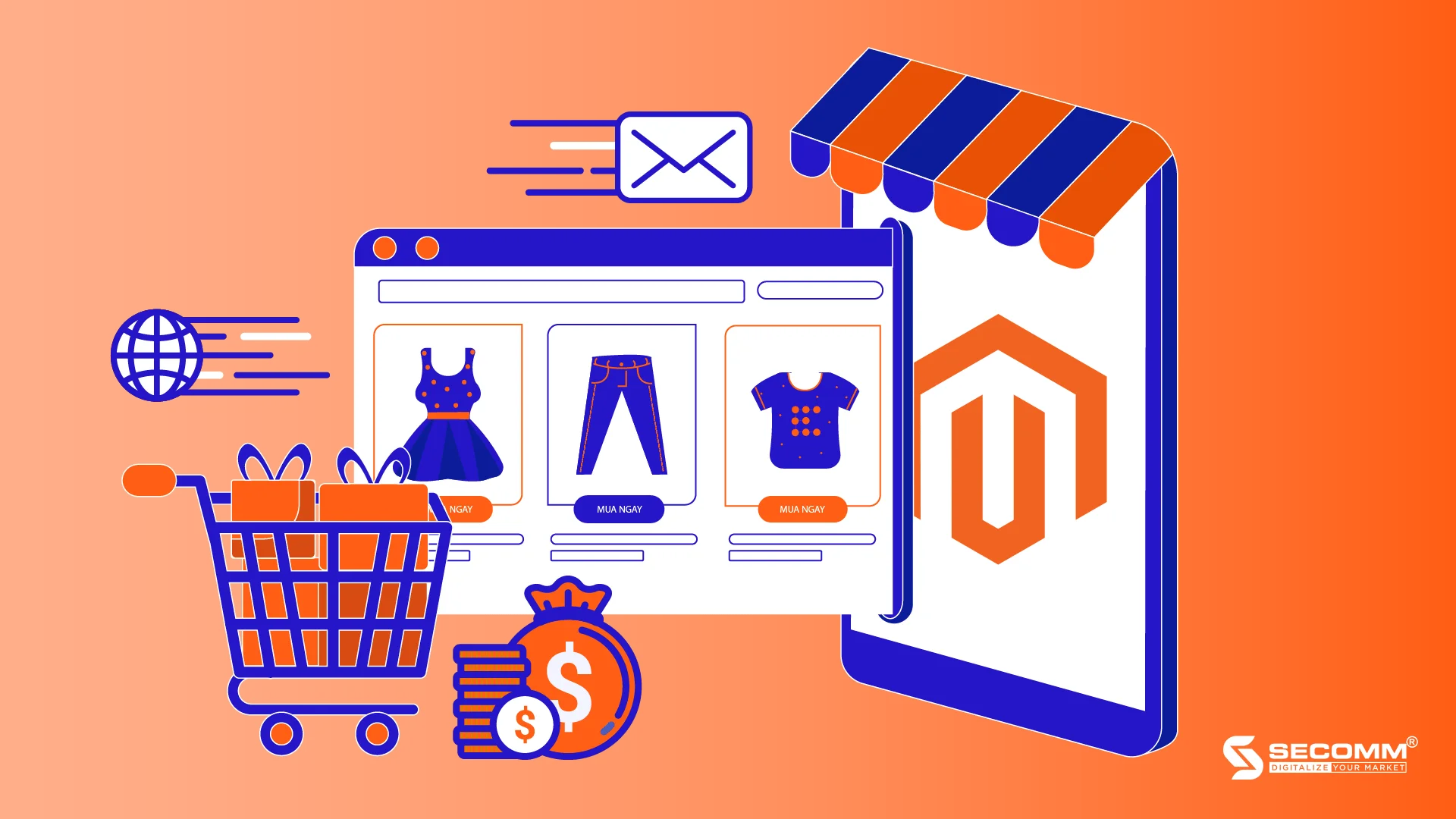
When deploying an ecommerce website, Magento is the top choice of platform that businesses are aiming for, including global giants like Nike, ASUS, HP, and Burger King, as well as leading Vietnamese enterprises such as Canifa, CellphoneS, Trung Nguyen, and CGV Vietnam.
With outstanding advantages ranging from a diverse ecosystem and flexible customisation capabilities to absolute security, Magento is considered the ‘ultimate boss’ among ecommerce website development platforms today.
So, what are the superior points of Magento?
Magento possesses all the features for a complete ecommerce website:
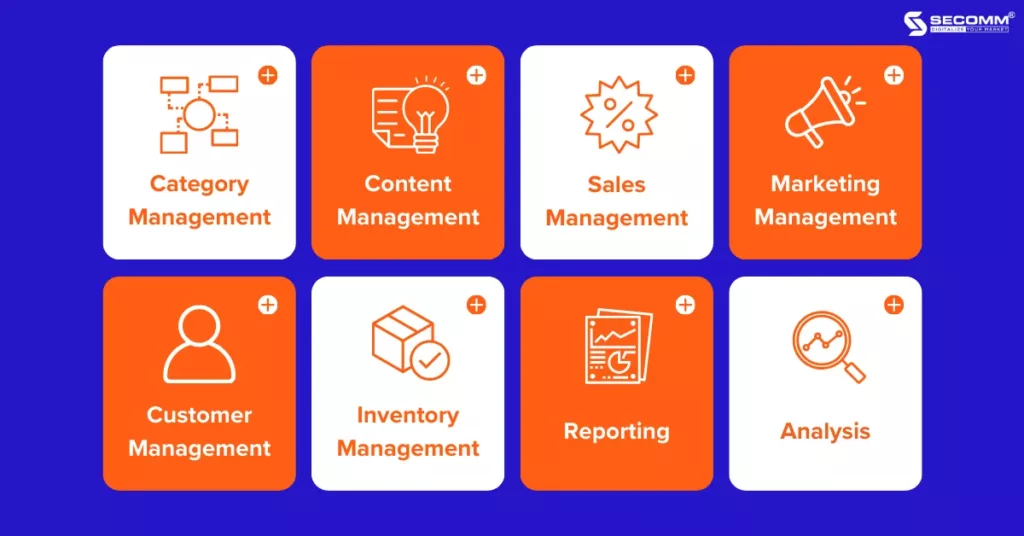
In addition to the basic features of a complete ecommerce website, Magento also owns a diverse system of extensions with many advanced functions in themes, products, marketing, optimal payment solutions, shipping, etc. to meet every operational need and ensure sustainable development of ecommerce for businesses.
When building an ecommerce website, Magento also supports businesses to integrate and link third-party services for efficient ecommerce website operation, such as:
Furthermore, Magento also has a global technical support community, including many rich experts and professional developers to meet all the requirements of businesses.
The Magento ecommerce website platform possesses all the advantages of open-source software with flexible customisation capabilities to operate the ecommerce website more effectively.
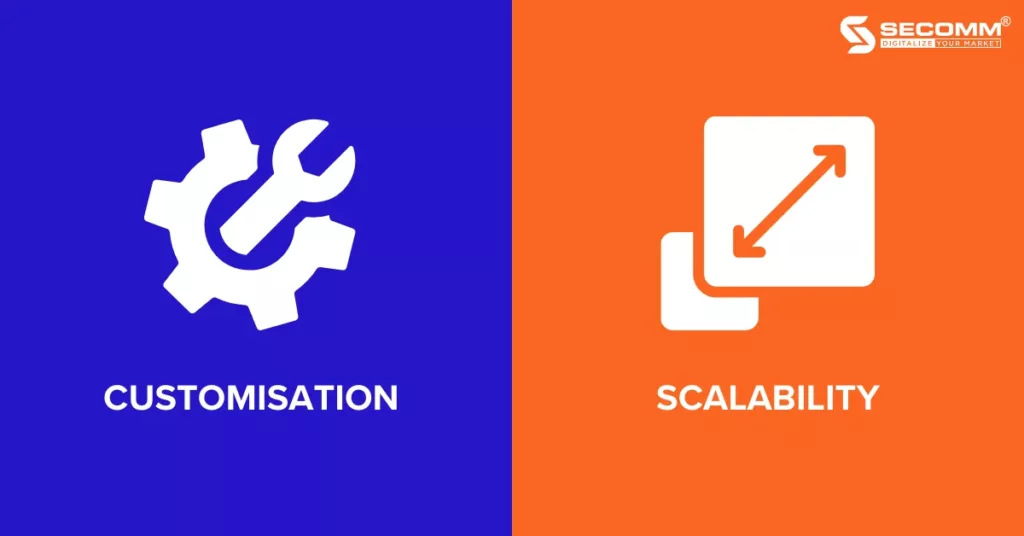
High security is also a superior advantage of Magento compared to other ecommerce website platforms, helping businesses minimise potential risks from data systems and transaction processes on the system.
Some outstanding points of Magento’s security features include:
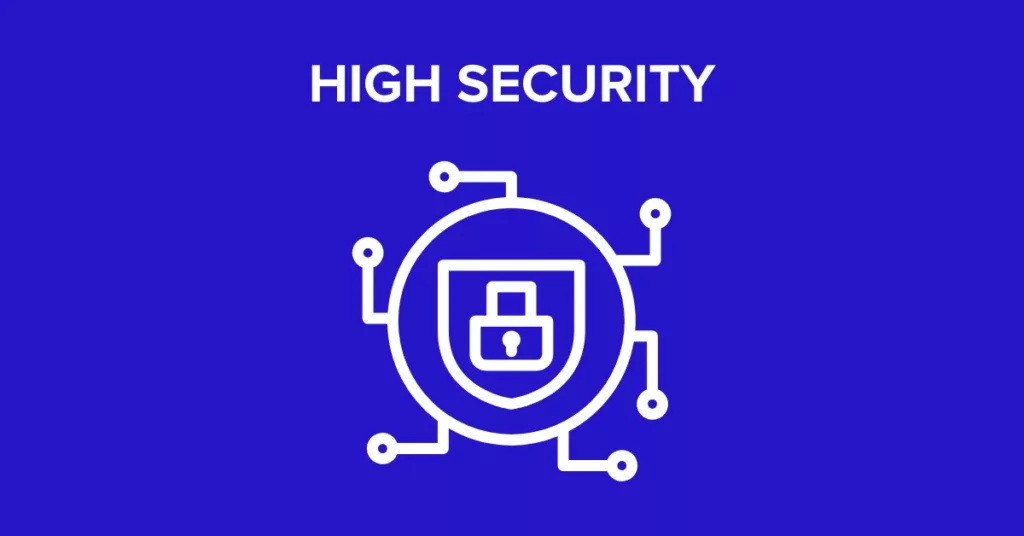
With the advantages of having all ecommerce website functions, from basic to advanced, high customisation capabilities, and high security, Magento is the top choice for businesses when deploying an ecommerce website system. However, issues related to costs, time, and the requirement for a highly specialised technical team make it challenging for many businesses to implement an ecommerce website system with Magento.
Contact SECOMM now for FREE CONSULTATION SUPPORT!
 2
2
 3,870
3,870
 0
0
 1
1Subscribe to get the latest eBook!
Hotline